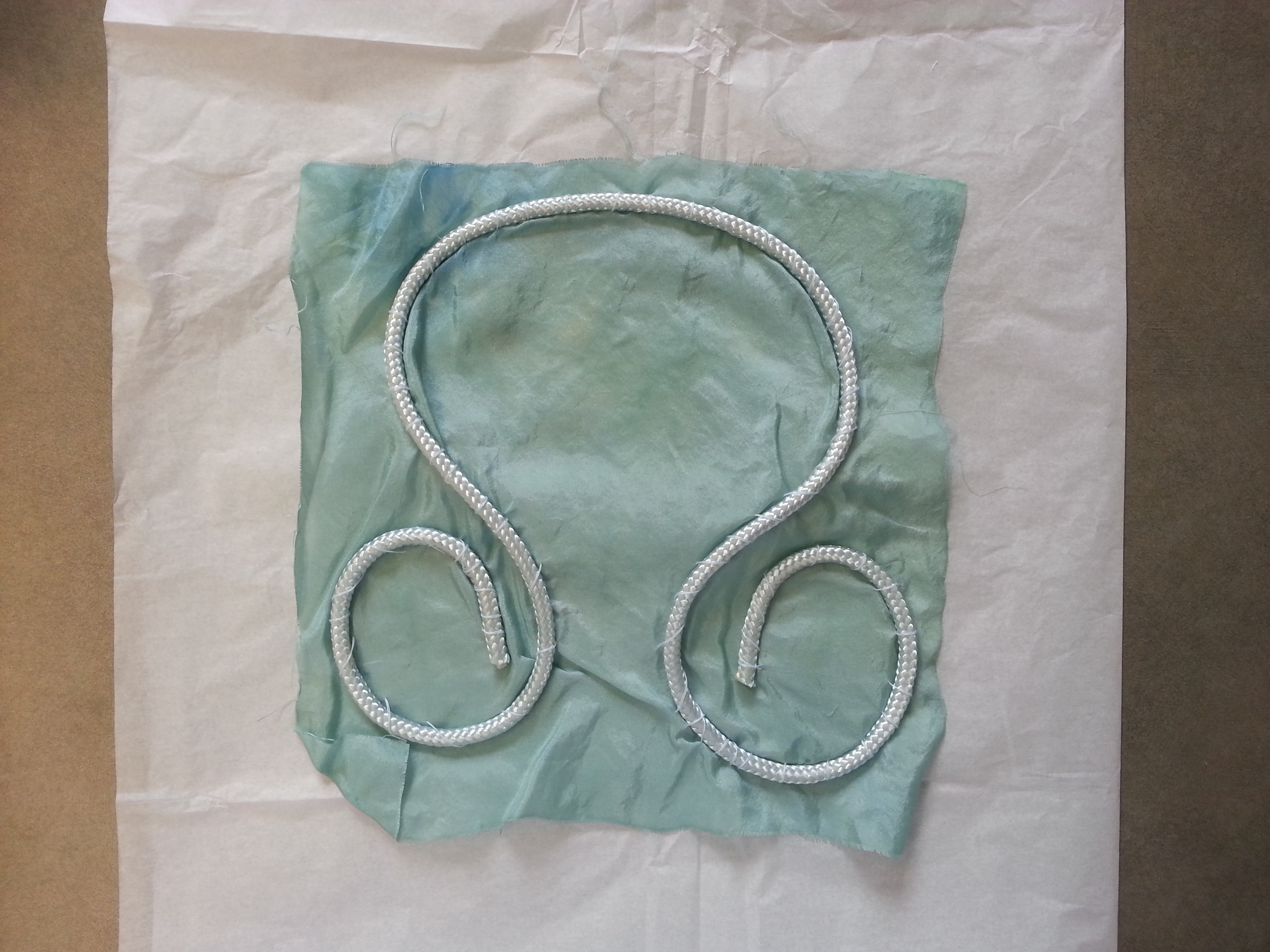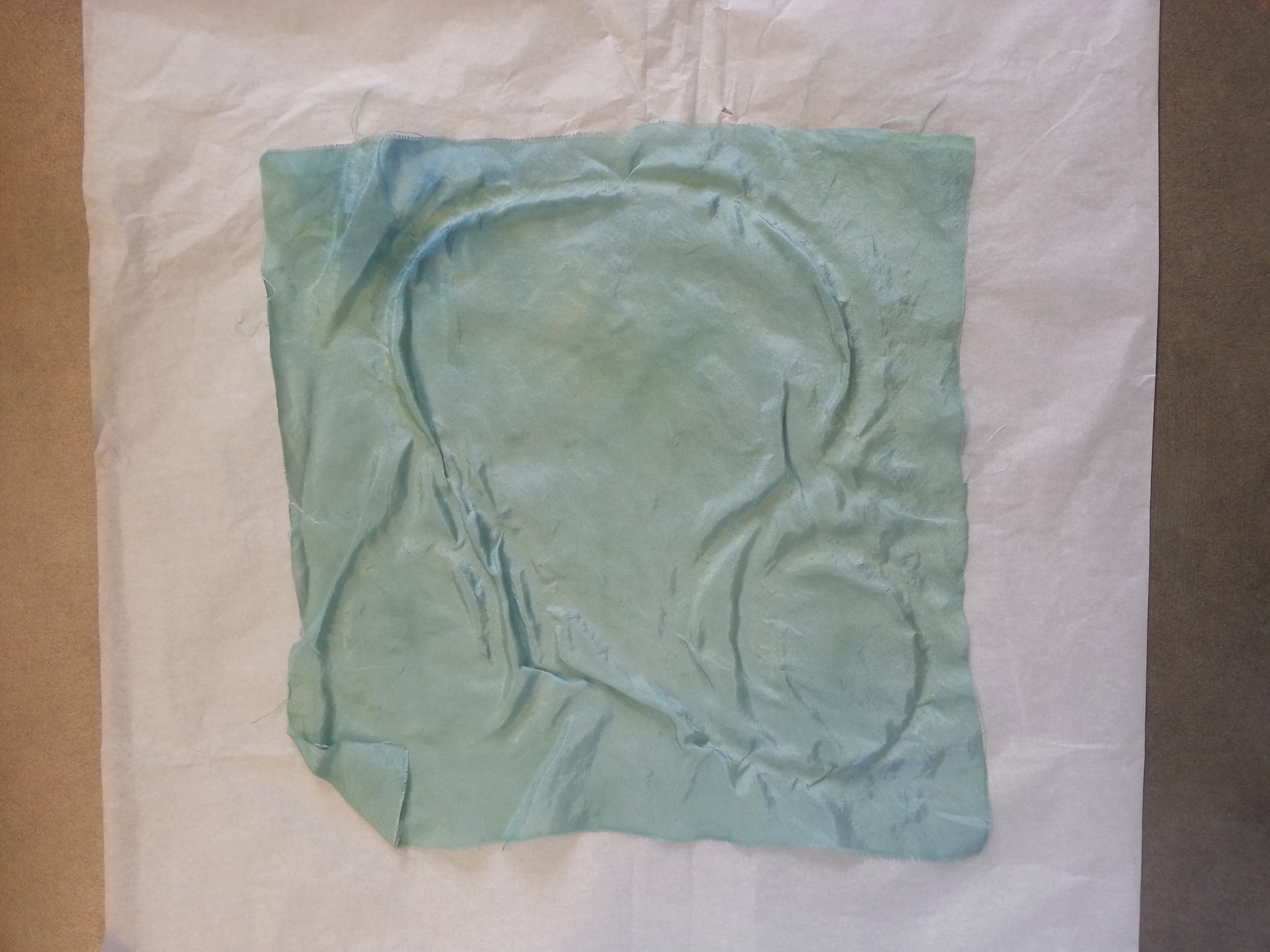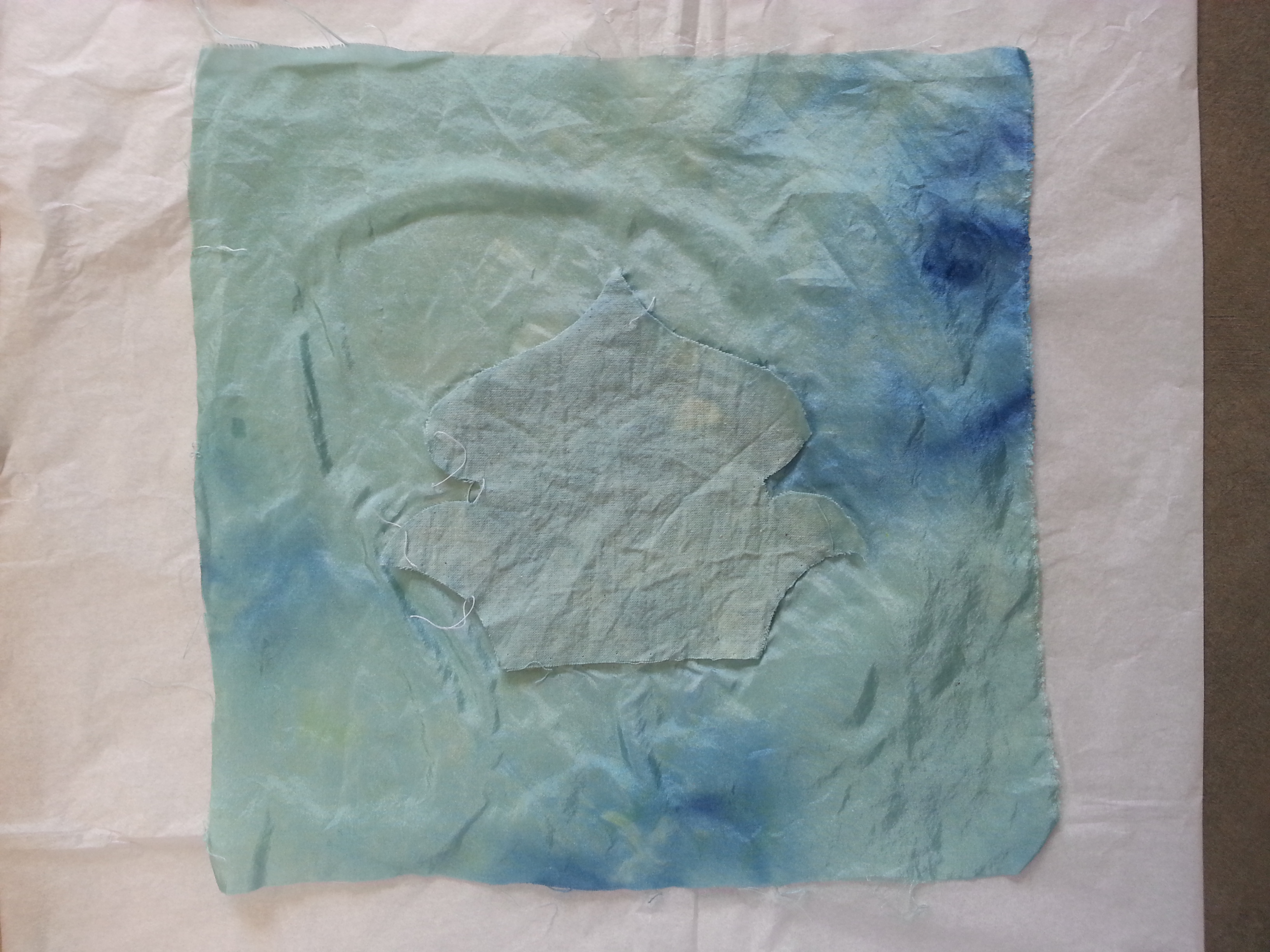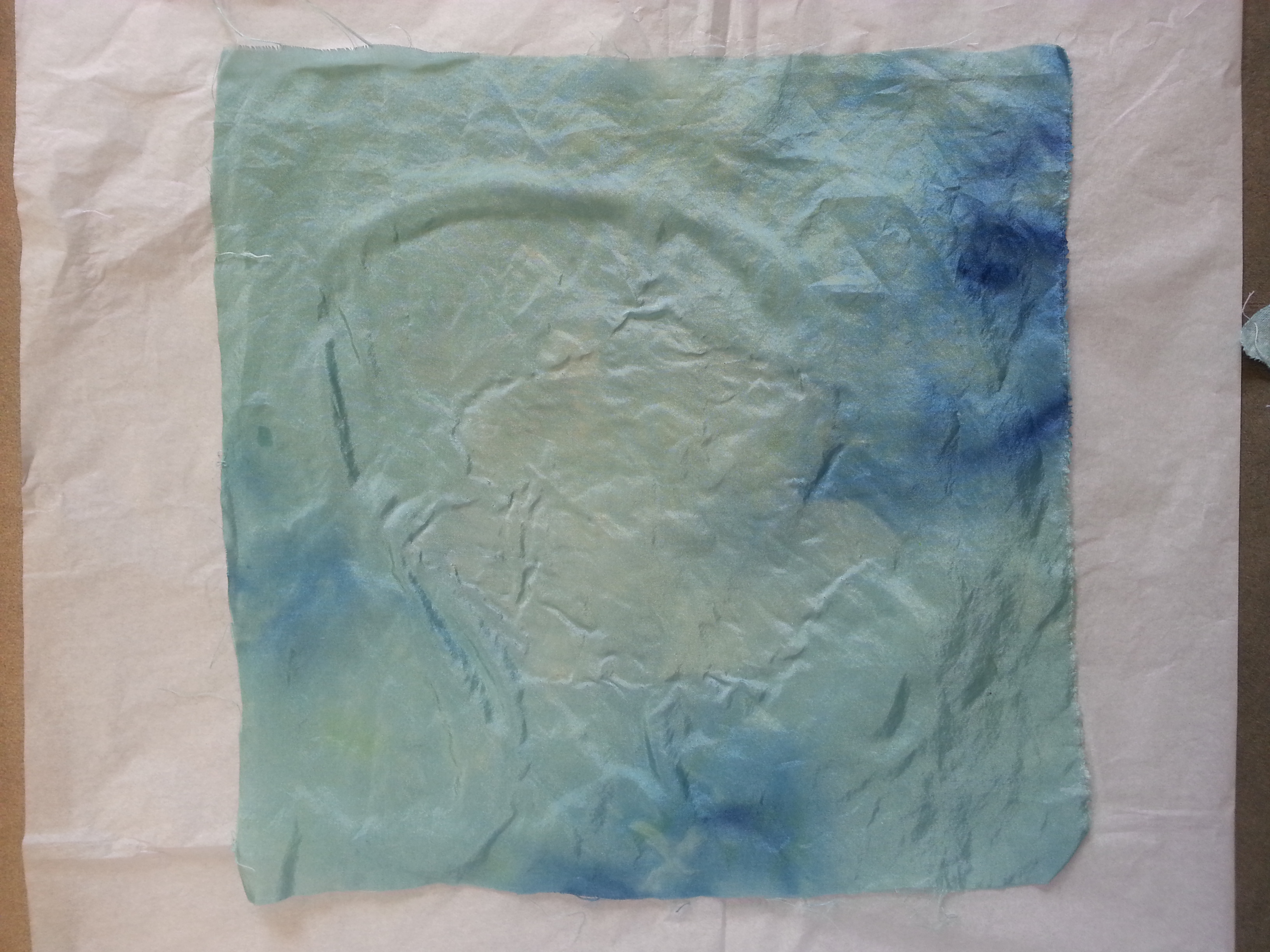[Scouring Fabrics]
Name: Yuan YiDate and Time
2015. Nov. 14, 3:00 PM
Table of Contents
Subject: Making washing soda
Washing soda is an ingredient needed to scour cotton in order to remove the dirt and grease accumulated in the course of manufacturing. As the impurities obstruct even penetration of dyes, scouring is a key process in natural dyeing.
I made washing soda by baking baking soda, drawing upon a recipe in this website:
http://www.pennilessparenting.com/2011/01/homemade-washing-soda.html#
- Placed baking soda on a dish and baked it for an hour at 400 F.
- Baking soda was transformed into washing soda and I could feel the difference in texture.
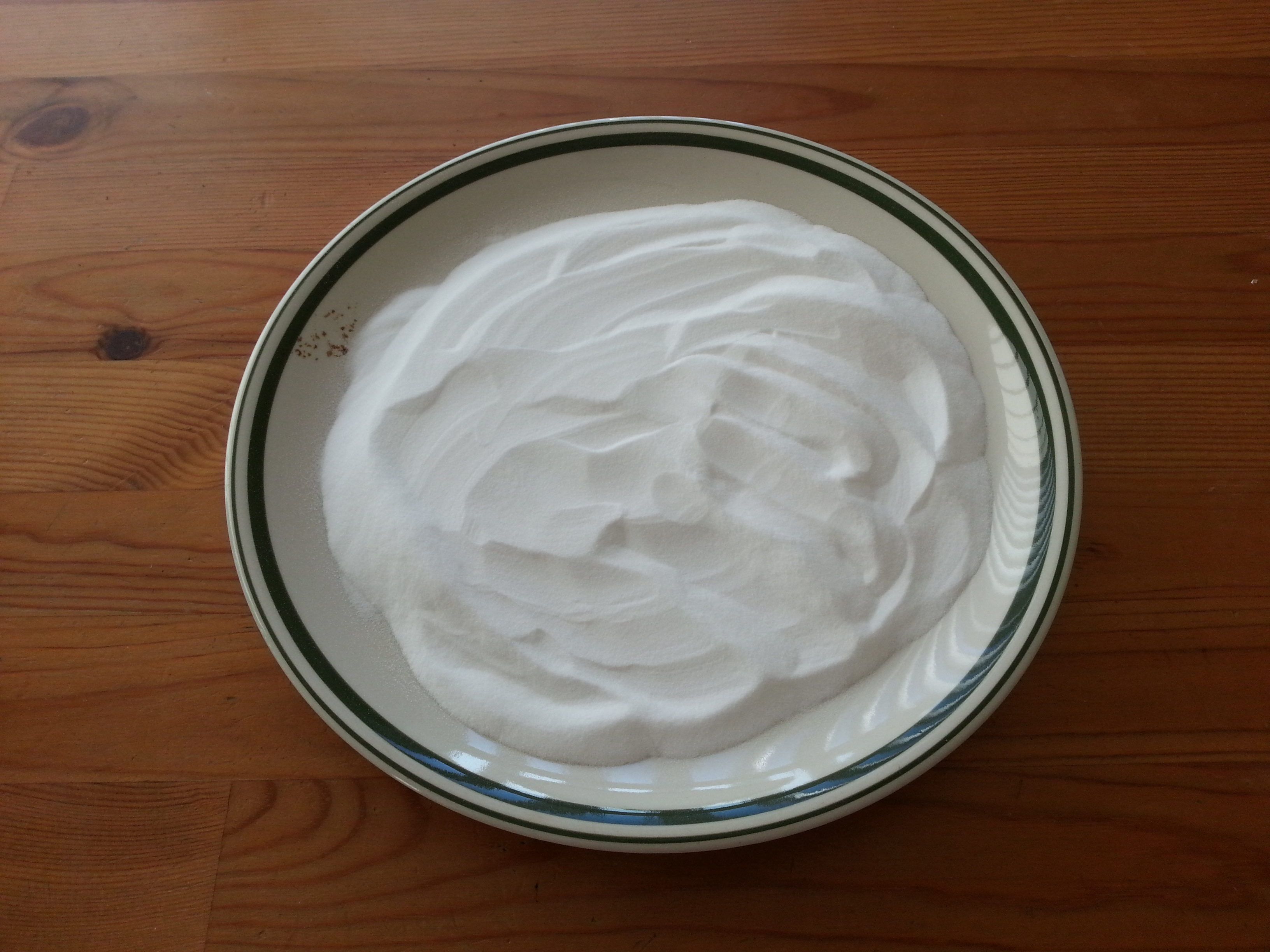 |
| baking soda |
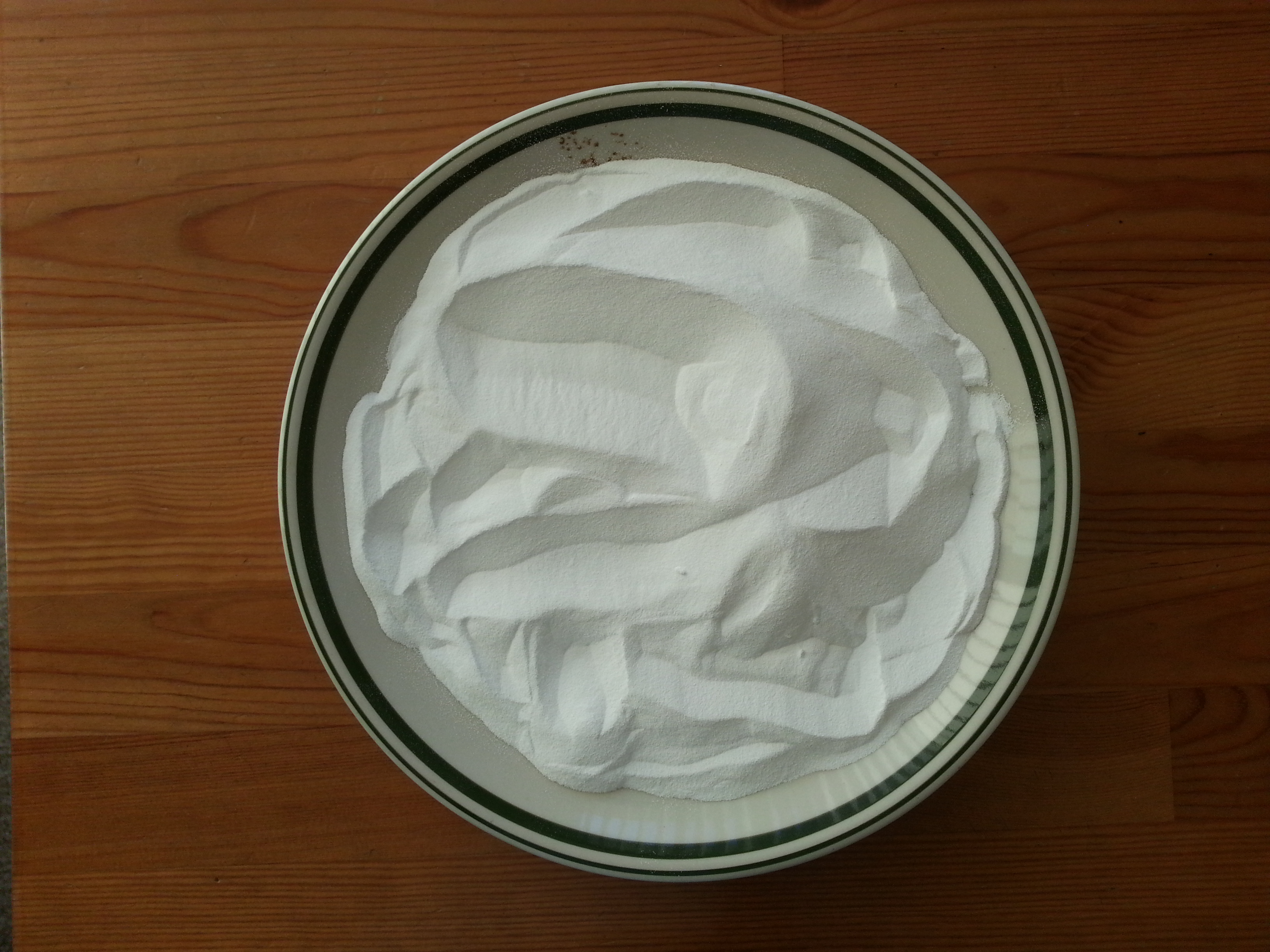 |
| washing soda |
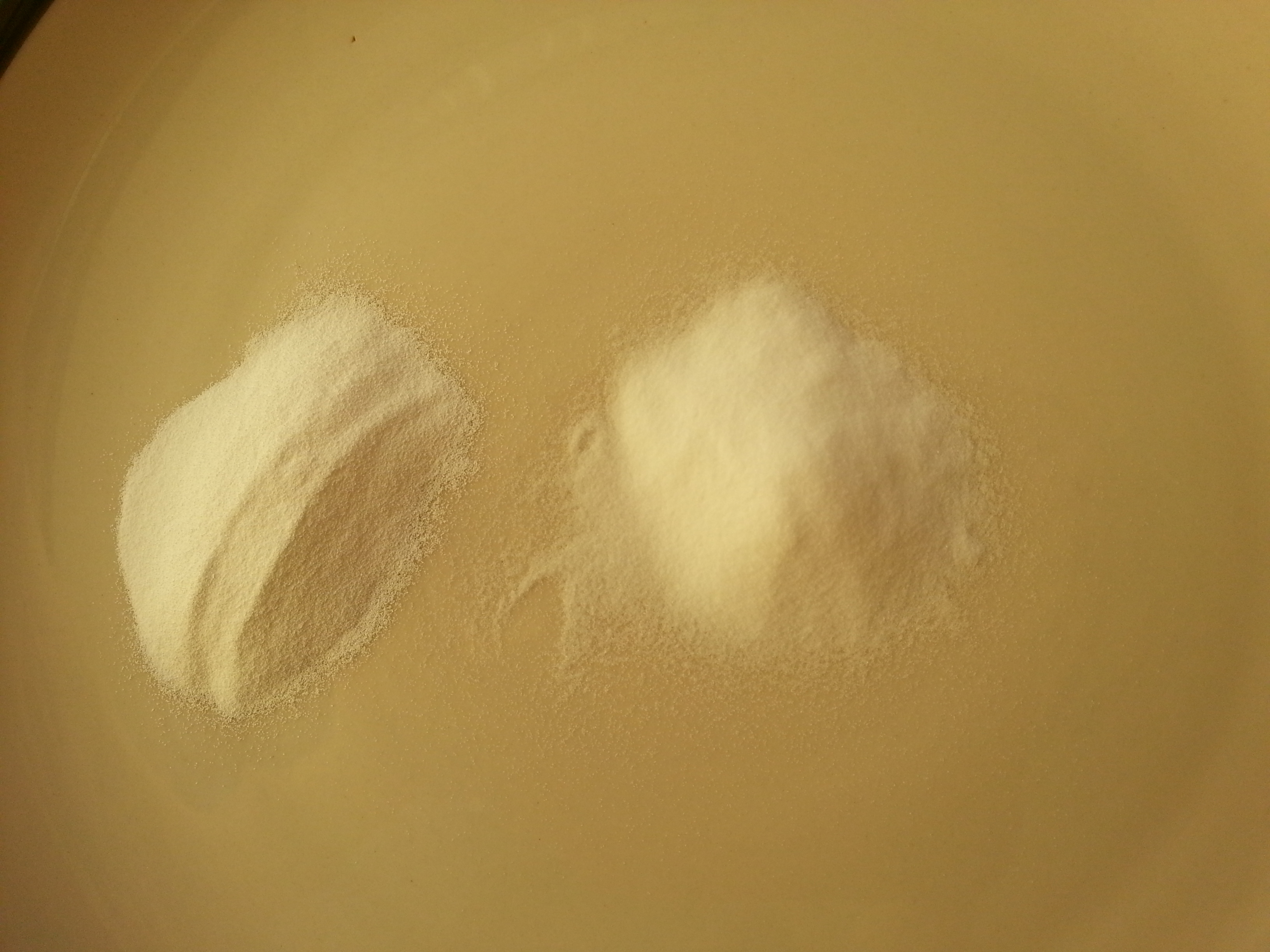 |
| washing soda (left) and baking soda (right) |
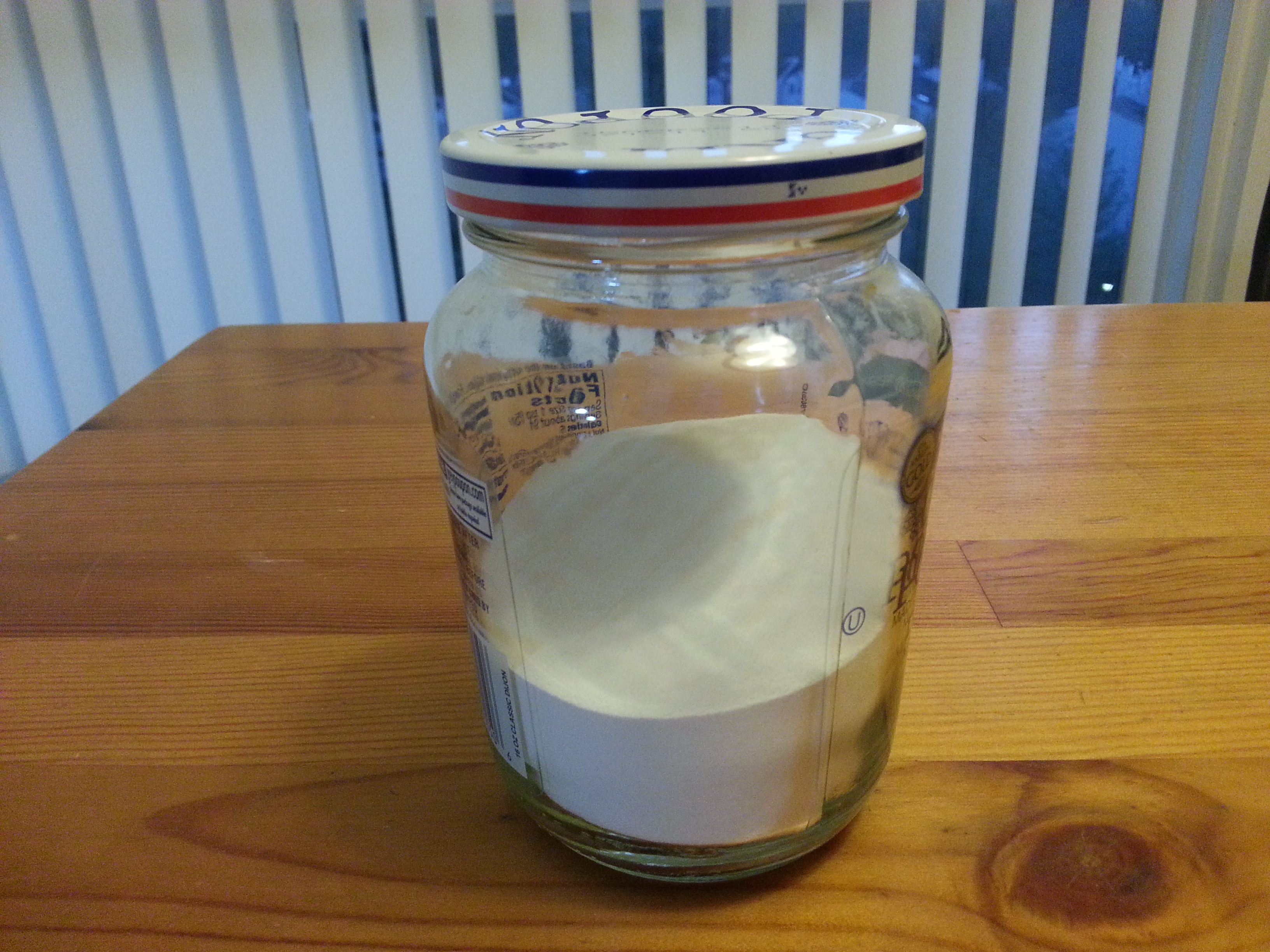 |
| washing soda ready for use |
Name: Yuan Yi
Date and Time:
2015. Nov. 14, 4:15 PM
Location: Greenbelt, Maryland (52 F, sunny)Subject: Scouring cotton fabric
- Weighed the fabric: 177.8g (appr. 6 oz).
- Filled a stainless steel pot with 3 gal of tap water (minimum 0.5 gal of water per oz of fabric).
- Added 3 tsp of laundry detergent, 12 tsp of washing soda.
- Placed cotton in the pot and brought to a boil.
- Began to boil at 5:00. Lowered to simmer.
- Let simmer for 3 hours.
- Removed from heat and let cool overnight
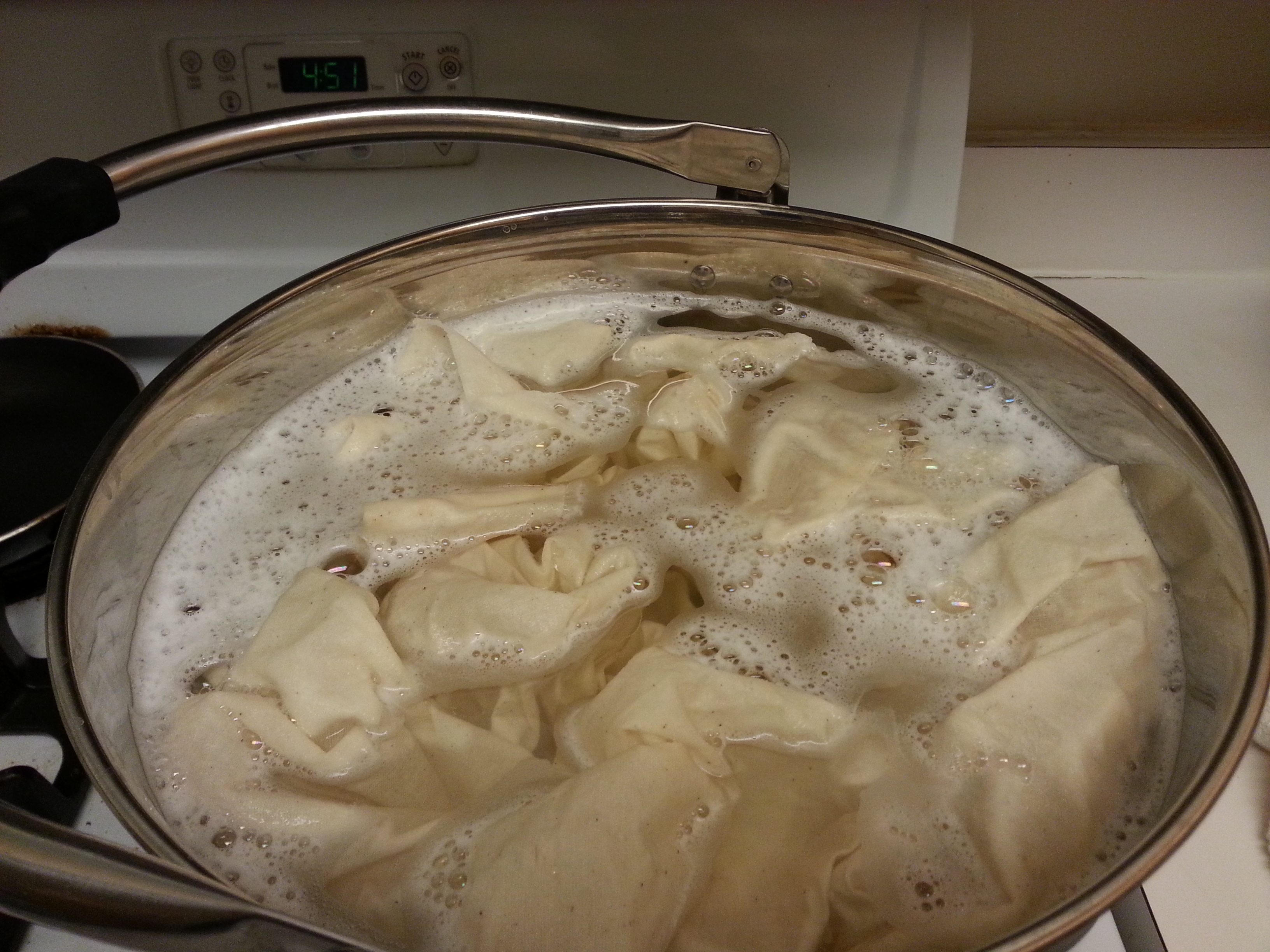
Name: Yuan Yi
Date and Time:
2015. Nov. 15, 10:00 AM
Location: Greenbelt, MarylandSubject: Rinsing cotton fabric
- Rinsed the cotton fabric 7 times and then air-dried.
- Fully dried in 2 hours.
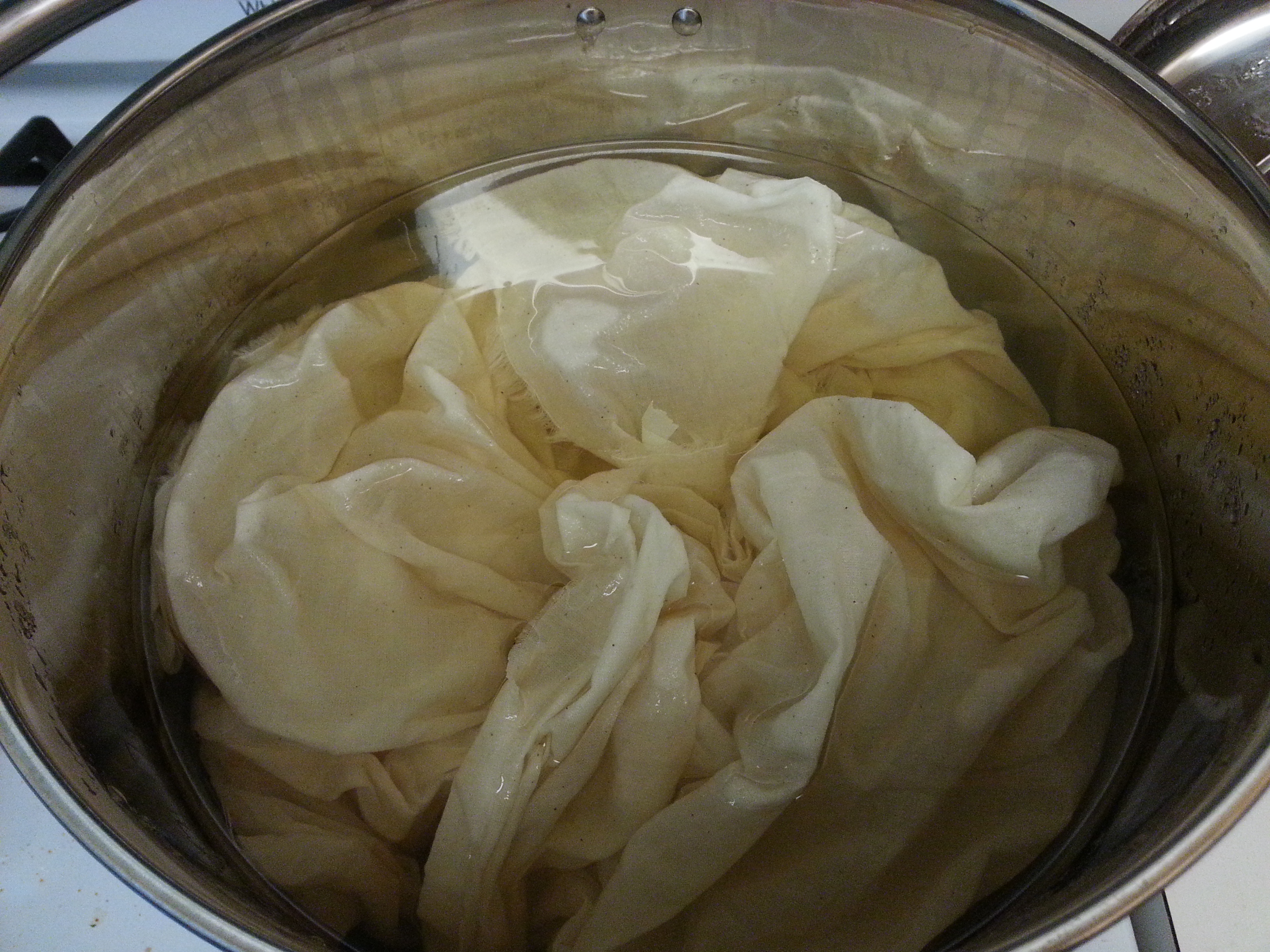
Name: Yuan Yi
Date and Time:
2015. Nov. 15, 2:00 PM
Location: Greenbelt, MarylandSubject: Cleaning silk fabric
- Put 1T of woolite in 2 gal of tap water.
- Soaked degummed silk and washed.
- Let it soak for an hour.
- Rinsed it more than 10 times and air-dried.
[Dyeing Yellow: Saffron]
Name: Yuan Yi, Cindy Kok
Date and Time:
2015. Nov. 16, 12:57 PM
Location: Chandler 260Subject: Making Lye for Dyeing with Saffron
We consulted a modern recipe for making lye from this site:
http://www.countryfarm-lifestyles.com/make-lye.html#.VkK30rerSUk
- Measured 2 beakers of 500 ml of water.
- Measured 60g washing soda x2.
- Measured 60 g quicklime x2.
- Placed each beaker on a burner around 1:10pm.
- Began boiling around 1:15pm.
- 1:18 adjusted boiler on right to 2 to see difference in boiling.
- 1:20 adjusted boiler on right to 3, boiler on left to 2.
- 1:24 roiling boil on right side, turned down to 2.
- Continued to adjust boilers to keep them gently boil.
- Smells faintly like baking bread? burnt toast?
- Turned off at 1:35 pm.
Name:Yuan Yi, Cindy Kok
Date and Time:
2015. Nov. 16, 3:27 PM
Location: Chandler 260Subject: Processing Saffron
- Placed a steel plate on the burner set to 1.
- Placed cotton cloth on the plate and then 1g saffron on the cloth.
- Warmed for 15 min.
- Put heated saffron in 170 ml of lye (modern manual says .1g for 500 ml but can be varied for color concentration).
- Unspecified soaking time in lye, left saffron soaking overnight.

Name:Yuan Yi, Cindy Kok
Date and Time:
2015. Dec. 14, 1:00 PM
Location: Chandler 260Subject: Saffron Dyeing
- We decided to focus on weld dyeing but just wanted to soak cotton and silk in the saffron-lye solution to see if it can dye.
- Soaked them for 15 minutes and rinsed lightly.
- Obtained very faint yellow colors--hard to tell the fabrics are dyed yellow.
Name: Yuan YI
Date and Time:
2015. Nov. 22 (Recipe Research on Saffron)
Location: Greenbelt, MDSubject: Further Research on Related Recipes
1) To dye threede, yarne, or lynnen cloth into a sad browne.
(http://eebo.chadwyck.com.ezproxy.cul.columbia.edu/search/fulltext?ACTION=ByID&ID=D10000998505980437&SOURCE=var_spell.cfg&DISPLAY=AUTHOR&WARN=N&FILE=../session/1448212903_6190#Hit2)
TAKE a pounde of bastarde Saffron, the which you shal put into a litle bagge and hang it in riuer water a daye and a night. Than washe it so muche, that it geue no more yellow colour: this done, make a rancke of Saffron in a pot not to thicke, than a rewe of Saffron, and a rewe of ashes, and couer it well, and let it stande seuen or eyght hou|res: than take eyght pottes of water, foure pottes of Uinaigre, and putting the Saffron with the ashes in a long bagge and sharpe pointed at the ende: strayne xv. or. xvi. tymes the sayde water and Uinaigre tho|rowe it whote. And this is the last dying or colour.
Than take againe as much water and Uinaigre, and straine it thorowe, and this shalbe the seconde dying. Do the lyke yethyrd tyme, & it shalbe the thyrd dying.
This colour you shall heate, and laye your threede or linnen clothe in it the space of a nyghte, than bang it vp without wringing or rubbing it. Do in like maner with the seconde colour and with the thyrde, but let it lye in it that seuen houres long.
Primary Source information
Title: The thyrde and last parte of the Secretes of the reuerende Maister Alexis of Piemont, by him collected out of diuers excellent authours, with a necessary table in the ende, conteyning all the matters treated of in this present worke. Englished by Wyllyam Warde. 1562. Author: Ruscelli, Girolamo.
This book has a section titled "THE thyrde Booke, for to dye threede, yarne, or linnen clothe, teaching howe to make the dying colours, and also to dye bones and hornes, and to make them softe, vnto what forme and fashion a man wyll," which includes several recipes for dyeing fabrics.
Questions and Findings
- It uses saffron, but it's for getting brown instead of yellow. It's interesting to know, though.
- Interestingly this section does not talk about weld or woad.
- In this recipe, ash, the key element of lye, was used again. What was its function? (See articles that Naomi sent to me days ago)
- alum (alome) is used in other recipes for making different colors. see below for instance:
Another waye to dye blewe.
TAke thre partes of ashes of lees burned, one parte of vnsleket syine, and make therof lye, let it clari|fie and than strayne it thorowe a course linnen cloth take pots of the same water, & powre it vpo~ a pound of Flaunders blew, such as is taken of the di|ers awdrons, mingle them wel together with a stick. Than set it on the fyer vntill you can skante endure your hande in it. But before you dye anye thing, you must haue your linnen cloth boyled in Alome and dri|ed agayne, and plunged afterwarde in the whote Lye twyse or thryse, according as you wyll haue the colour darke or cleare. The substaunce must be whote before you occupye it.
Another waye.
TAke vnsleckt lyme, and put a litle water vpon it, and let it stand a night, and afterward straine the clearest thorow a linnen cloth, and for euery pinte of water put in halfe an vnce of scraped Brasyl. Let it seeth vnto the halfe, and put to it halfe an vnce of A|lome, set it vpon wodde, and let it heate but not seeth. Whan you wil, haue that you wil die readie prepared in such sort as here foloweth. Take lees of redde wine and put it in a bagge· that al the wine dreane out, and the lees waxe drie. Make thereof balles as bigge as a hennes egge drying them in the Sunne, and burnyng them after into ashes, and of this ashes make a strong Lye, and make it verye whote, and than weate in it the thing that you will dye, drying it afterwarde, and than dye it with the foresayde colour.
- I am using this dictionary for medieval English: http://quod.lib.umich.edu/cgi/m/mec/med-idx?size=First+100&type=orths&q1=skinne&rgxp=constrained
2) To dye the saied bristels yellowe, greene, or blewe, or any other colour.
FIr&s;te you must wasshe them, and let theym boyle in Alome water, as the other before: than take Ligustrum, and saffron, if you will haue them yellowe. Indicum, or the iuyce of elder berries, or walwort, or els of the flow+ers of Ireos, if you will haue them blew. If you wil haue them greene, take paynters greene, and dresse them as is aboue saied, assayinge sometime if the coloure please you. And by this meanes you maye dye theim what co|lour you liste.
Primary Source information
Title: The secretes of the reuerende Maister Alexis of Piemount Containyng excellent remedies against diuers diseases, woundes, and other accidents, with the manner to make distillations, parfumes, confitures, diynges, colours, fusions and meltynges. ... Translated out of Frenche into Englishe, by Wyllyam Warde. 1558. Tuscelli, Girolamo
Questions and Findings
- The recipe is for dyeing hog bristels but I could perhaps use it for dying fabrics?
- What is ligustrum?
- What is alome? Does it mean alum?
- These books do not mention weld (or woad) at all
[Dyeing Yellow: Weld]
Name: Yuan Yi
Date and Time:
2015. Nov. 20 (Recipe Research on Weld and Yellow)
Location: Greenbelt, MDSubject: Further Research on Related Recipes
Related Recipes from the BnF
1) 056r_ai
<title id=”p056r_a1”>Trempe excellente pour corps de<lb/>
cuirasse</title>
<ab id=”p056r_b1a”>Ayes eau de riviere la plus claire et la plus courante<lb/>
quil sera possible & fais la chaufer un peu plus que tiede<lb/>
Puys ayes une botte de gaulde et en prens la grene & la<lb/>
mects dans ladicte eau et la fais fort bouillir la remuant<lb/>
avecq un baston puys verse la dans un muy ou aultre<lb/>
vaisseau puys gectes dedans deulx picotins de sel</ab>
English translation: Excellent temper for breastplates
Have the clearest and the most running river water you can, and heat it up slightly more than warm. Then have a bunch of reseda, take its seeds and dip them into the said water and bring it to a rolling boil it while stirring it with a stick. Then pour it into a muid or any other vessel, then throw into it two pecks of salt. Then take a big cauldron full of the said river water and heat it up slightly more than warm. Take three or four times the quantity of red greasy earth you can hold in two cupped hands, dip it and throw it into the cauldron filled with the said water. Have as much pigeon manure as of the said earth, as much horse manure and as much iron scrapings. And mix each of these separately, throw into the caldron and leave for two or three days. Then throw it into the said muid and stir all strongly altogether. And the older this temper is, the better it will work.
2) 010r_2
<id>p010r_2</id>
<head><m>Scudegrun</m></head>
<ab>Il se faict a <pl>lyon</pl> avecq du <m>suc de gaulde</m> & de la <m>croye</m> incorporee<lb/>
ensemble ou pour mieulx avecq de la <m>ceruse</m> qui est propre a<lb/>
destrempe et a <m>huile</m></ab>
</div
English translation: Stil de grain yellow
It is made in Lyon from the sap of weld mixed with chalk or better yet with ceruse, which is appropriate for temp
Questions
- Weld is gaulde in French. I looked up the word in the BnF files and found two recipes. The gaulde in 056 was translated into reseda and the one in 010 into weld. I do not understand why. I also wonder how the gaulde functioned differently in each recipe. None of them specifies how to process weld for dyeing fabrics. I will have to rely on other recipes.
- https://en.wikipedia.org/wiki/Reseda_luteola
Other Related Recipes
1) A recipe from Flanders and the Netherlands from Jo Kirby's book:
Idem for four pounds of wool yarn or cloth you shall take two pounds of weld. This weld is put in a kettle and clean water is added. To that is also added half a tin dish of ashes from the fire. And then, as soon as it boils, take your wool yarn and put it in. Thus let it boil for [the time of reciting] eight or nine Pater nosters. Then take our your yarn and put some water in your kettle and add also some ash from the fireplace. Then again put in your wool and let it boil for a good while (from Anon, Tbouck van wondre, 1513: 63, translated)
I found the same recipe, translated in English in the late sixteenth century:
To make this dye, put too foure pounde of woollen yarne, or cloth, two pounde of woad. Put this woad in a Kettle, and cast therein of fayre water, then cast agayne halfe a tin dishe full of ashes out of the fyre, and as soone as it seethes, put your woollen yarne therein, then let it seeth eyght or nyne pater noster whiles long, then putte your yarne forth, and put a little water in, out of the kettle, and then a few ashes out of the harth, and put your woollen yarne agayne therein: and so let it seeth a good while, if it be a broune blue, it shall be a darke greene, and if it be white woollen yearne, so it shal be a yealow colour.
Questions:
- What's the amount of "half a tin dish"? It that a measure word?
- What is Pater nosters? https://en.wikipedia.org/wiki/Lord%27s_Prayer
hallowed be your name.
Your kingdom come,
your will be done,on earth, as it is in heaven.
Give us this day our daily bread,and forgive us our debts,
as we also have forgiven our debtors.
And lead us not into temptation,
but deliver us from evil.
My protocol:
- Prepare 500 ml of tap water in each 1000 ml beaker (will test with 3 beakers)
- Measure dried weld and put it in the water (its weight would be half the fabric)
- Add some pine ash (in the lab inventory) I am not sure how much I have to weigh it out.
- As soon as they boil, add cotton, silk, linen fabric in each beaker
- Boil them for 4-5 min (given that one Pater noster takes 30 seconds or so)
- Take out the fabrics
- Add 100 ml water to each beaker and some more ash
- Put the fabrics again
- Boil for another 10 min
2) Yellow recipes from a dutch book for dyers translated in English in the sixteenth century:
(http://eebo.chadwyck.com.ezproxy.cul.columbia.edu/search/fulltext?SOURCE=var_spell.cfg&FILE=../session/1447005465_2339&ACTION=ByID&ID=D00000545324170000&DISPLAY=AUTHOR&ECCO=N&WARN=N&SIZE=153)
2-1) To dye a fayre yealowe.
If ye will dye yealow with wood, take off the wood leaues, and cut off the rootes, then cut them in peeces, and lay them to soke in lye of commo~ ashes three houres, then seeth it a quarter of an hower, till ye thinke it be meetely well sodde. Then put therein two quartes of water, and as much stale Vrine of sixe dayes olde at the least, so let them seeth together a little, then cleanse it thorow a siue, and then put vnto the same agayne, of lye and Vrine as aforesayd. Then strayne it thorow a fayre cloth and seeth it, and to two pounde of wood take two pounde of Verde|greace, with the lye that ye haue sod, your woad and all putting them in your sayd colour, which must be medled and well stirred all together. Then shall ye boyle it all a little, and it shall be well.
2-2) Another colour to dye a yealow with wood.
Take and set a pot with water on the fire, and make it warme, then take ashes made of Oken woade, and cast thereof into the pot with water, and being warme take it from the fyre, and fiyre it well. Then couer it close til the next daye. Then poore the clearest lye thereof thorowe a cloth softly into another vessel or pan, then take of good wood, and breake the rootes off, and then cut them small, then wash & rince them in cold water, & then put the~ into the lie, and there let them soke a night, then take & seethe it, til the halfe be consumed, and when it is well sod, then all hote, clense it thorow a fayre cloth, then must yee haue of verdegreace wel & finely beaten into pouder, and blend therof with a spoone amongst your other stuffe, this must be done incontinent therevpon, and also your lye thervn|to must be very strong made.
2-3) A fayre greene to dye.
If ye will haue a fayre greene, take a little branne wa|ter, and a little allum, and seeth them together, and when the Allum is molton, put your silke therein, and lette it seeth the fourth part of an houre. Then take again a little branne water, and a little wood, and put it therein also, till that it waxe a fayre darke yealow. If ye will haue it more yealower, then put it in the blue dye, wherein yee may make it light or darke as ye please.
2-4) To dye a greene.
Take a light blue colour and put it into Allum water two houres long, then hang it to the time, there as the wynde may drye it, and then put it into the foresayd wood and so vse it as it is afore declared.
2-5) To dye cloth with facet Wood.
As ye will dye cloth with faucet Wood, ye must make your lye with sope ashes of Denmarke, and rayne water, which ye shall let stand three houres long, then seeth it, but the Woad must be first sod in the lye, and when it is sodde, let it bee cooled with other colder and sharper lye, with the last lye ye shall put too one pounde of yearne, a great peece of Allum, and put it therein. Then shal ye put that dye into a fayre Kettle or fatte, then take two ounces of spanishe greene, which ye shal soke therein two or three houres long, then tosse and push it vp and downe twise or thrise, and wring it, and with colder lye put therein, and tesse it with a dishe too and froe. Also another manner is, take a dishe full of vnflect lyme, and quenche it with water, then take too dishe full of wood ashes, and mixe it with the chalke all together well, and there of yee shall make a good strong lye, and let it three or foure times run thorow the tubbe, then take the faucet woad, and hew or cut it in small peeces, & cast it into the lye, and let it seeth therein halfe an houre long. Then put therein sope ashes, and let it seeth another good halfe hower, take it then off, & put thereto spanish greene, & let it boile twise, or thrise, and then sponge it, also with three pound of faucet woad, it behoueth to haue two ounces of spanish green, & as the cloth haue bene in the first licor, if then it be too broune or too yealow, then put thereto of wyne ashes, & a little allu~.
2-6) To dye woollen yearne, or cloth.(this is identical with Jo Kirby's)
To make this dye, put too foure pounde of woollen yarne, or cloth, two pounde of woad. Put this woad in a Kettle, and cast therein of fayre water, then cast agayne halfe a tin dishe full of ashes out of the fyre, and as soone as it seethes, put your woollen yarne therein, then let it seeth eyght or nyne pater noster whiles long, then putte your yarne forth, and put a little water in, out of the ket|tle, and then a few ashes out of the harth, and put your woollen yarne agayne therein: and so let it seeth a good while, if it be a broune blue, it shall be a darke greene, and if it be white woollen yearne, so it shal be a yealow colour
2-7) To make a fayre yealow.
To make a yelow, that ye may worke with oyle, or water ye shal take woad, so much as ye shall please, & let it stand to soke a night and a day in lye made with sope ashes, and when it is thus soked, then shal ye seeth it, & couer it close so long as it seeth, thus done, then set it from the fire, & put that lycor into another pan, & so strayne it thorow a clea
 |
| Single illegible letter |
2-8) To dye a fayre yealow colour as Golde.
Lay first your linnen in allum water foure howers lo~g, then take one part of chalk, and two parts of wood ashes, then make a lye thereof, and seeth your dye therewith, al|so the best lye to dye with is, to take two partes of wood ashes, and one part of chalke, worke and vse it as yee shall perceiue best.
Questions
- What is wood? Does it mean weld? Hmm... it seems that weld was woad at that time. Then was wood just wood?
- It does not specify allum(alum), which is mentioned in other recipes in the same book.
Name: Yuan Yi, Cindy Kok
Date and Time:
2015. Nov. 23, 2:00-6:00 PM
Location: Chandler 260Subject: Dyeing Yellow with Weld
The only recipe with detailed instructions on the process of dyeing that I was able to find was a 16th-century Dutch recipe translated in English:
Idem for four pounds of wool yarn or cloth you shall take two pounds of weld. This weld is put in a kettle and clean water is added. To that is also added half a tin dish of ashes from the fire. And then, as soon as it boils, take your wool yarn and put it in. Thus let it boil for [the time of reciting] eight or nine Pater nosters. Then take our your yarn and put some water in your kettle and add also some ash from the fireplace. Then again put in your wool and let it boil for a good while (from Anon, Tbouck van wondre, 1513: 63, translated)
One of the biggest challenges that this recipe poses is the inadequate quantity information except for woolen yarns and weld.
- How big were the kettle and the tin dish? Were they commonly used measures at that time?
- How long did it take to recite the Pater Noster and what did the author mean by “a good while”?
My solution to the quantity issue was to use the size of the kettle as a guideline. I imagined a kettle that was big enough to hold water, weld, wood ash, and fabrics. Then I scaled it down to the size of a 1000 ml beaker. I imagined a tin dish, whose surface area would not have been greater than that of the kettle. Then I sourced a small metal plate that would match the size of the beaker in the same ratio as the kettle and the tin dish. As for the quantity of fabrics, I surmised that the author would have wanted to add a moderate volume of fabrics into the kettle so that it would not be too cramped or spacious. I placed each fabric in the 1000 ml beaker and adjusted its volume so that the fabric made the beaker neither cramped nor spacious. Then I measured the weight of the fabric. Finally I measured out three sets of weld proportional to the weight of the fabric that each set was going to dye following the 1:2 ratio specified in the recipe. We recited an English version of the Pater Noster nine times, which took three minutes and forty-five seconds. I conducted three experiments with different types of fabrics: silk, cotton, and linen.
Dyeing with Silk
- Sieved charcoal ash.
- Prepared a beaker of 500 ml water.
- Placed 12-13 g of charcoal ash and 4g weld.
- Began to heat at 2:57.
- When it began to boil at 3:20, I added 8g of silk and recited the Pater Noster 9 times, which took me 3 min 45 sec.
- Removed the silk, added 100 ml water and 3-3.5 g charcoal ash, then placed the silk back into the beaker (kept the burner on).
- Began to reboil at 3:30.
- Removed from heat at 3:45.
- Let it cool down for 10 min and washed 5 times until the yellow color was no longer seen.
- Air-dried in the lab. Fully dried in 30 min.
Dyeing with Linen and Cotton
- Prepared two beakers of 500 ml water.
- Placed 12-13 g charcoal ash and 9.5 g of weld in each beaker.
- Began to heat the beakers at 4:30 but they hardly boiled, making very slow progress.
- Moved the burners to different stations.
- Began to heat at 5:00.
- The beaker for linen began to boil at 5:11. Added 19 g of linen and waited for 3 min 45 sec (I did not recite the Pater noster myself this time).
- Took out the linen, added 100 ml water and 3-3.5 g wood ash, and placed the linen back in the beaker.
- Began to reboil at 5:18 and removed from heat at 5:33.
- The beaker for cotton began to boil at 5:18. Followed the procedure in the same manner (added 19 g of cotton). removed from heat at 5:44.
- Rinsed 5-6 times until the yellow color was no more seen in the water.
- Air-dried.
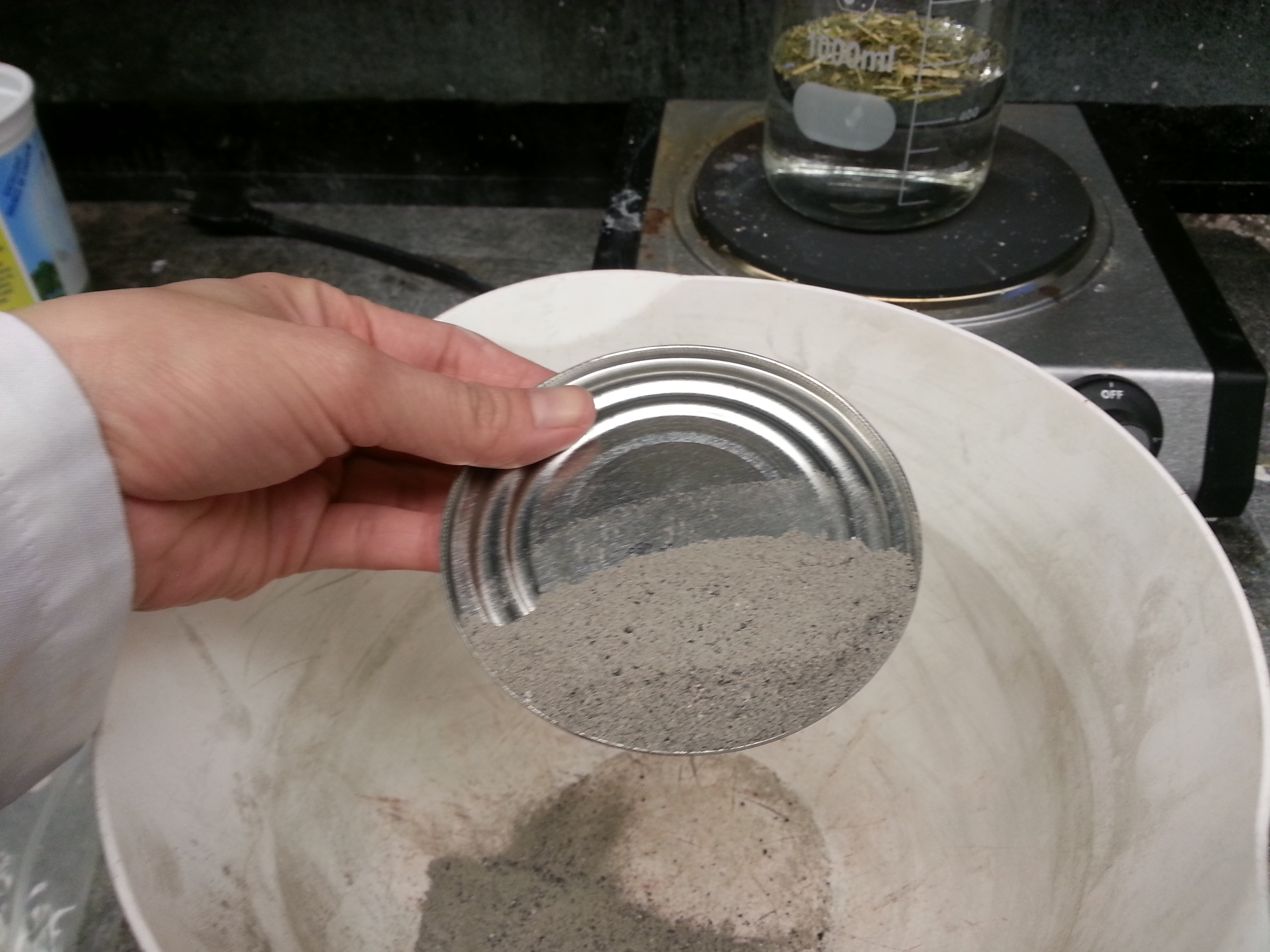
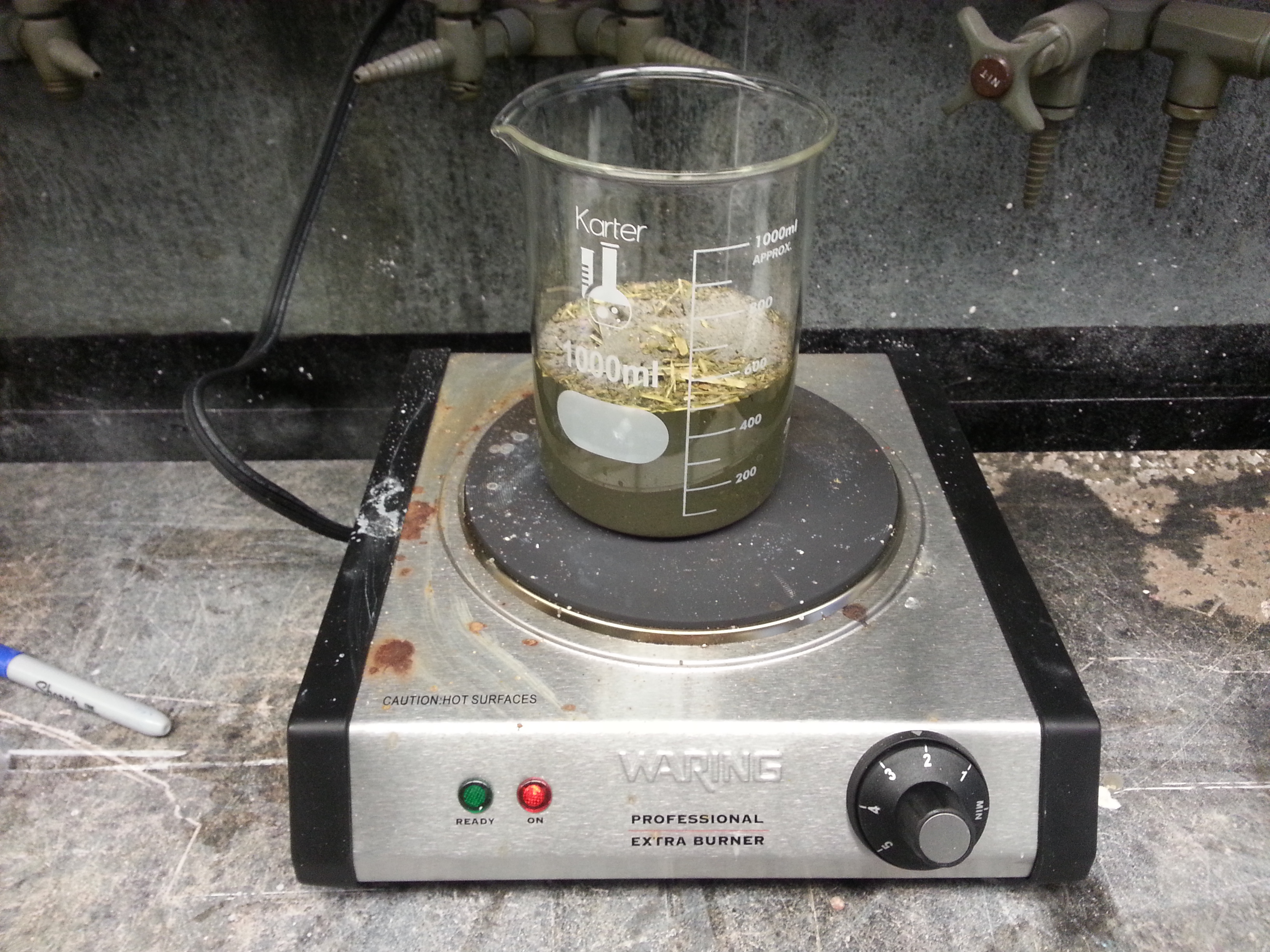
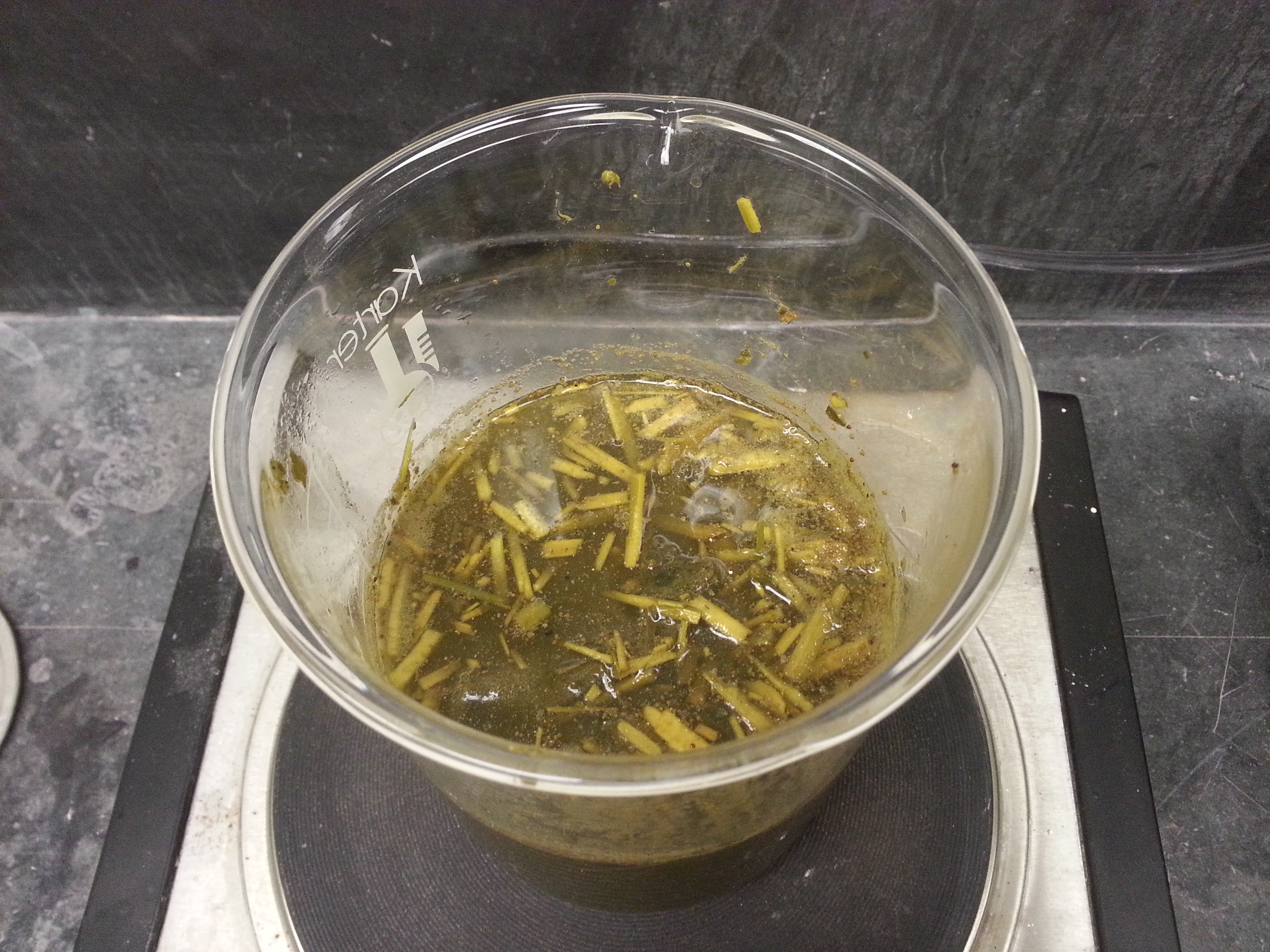
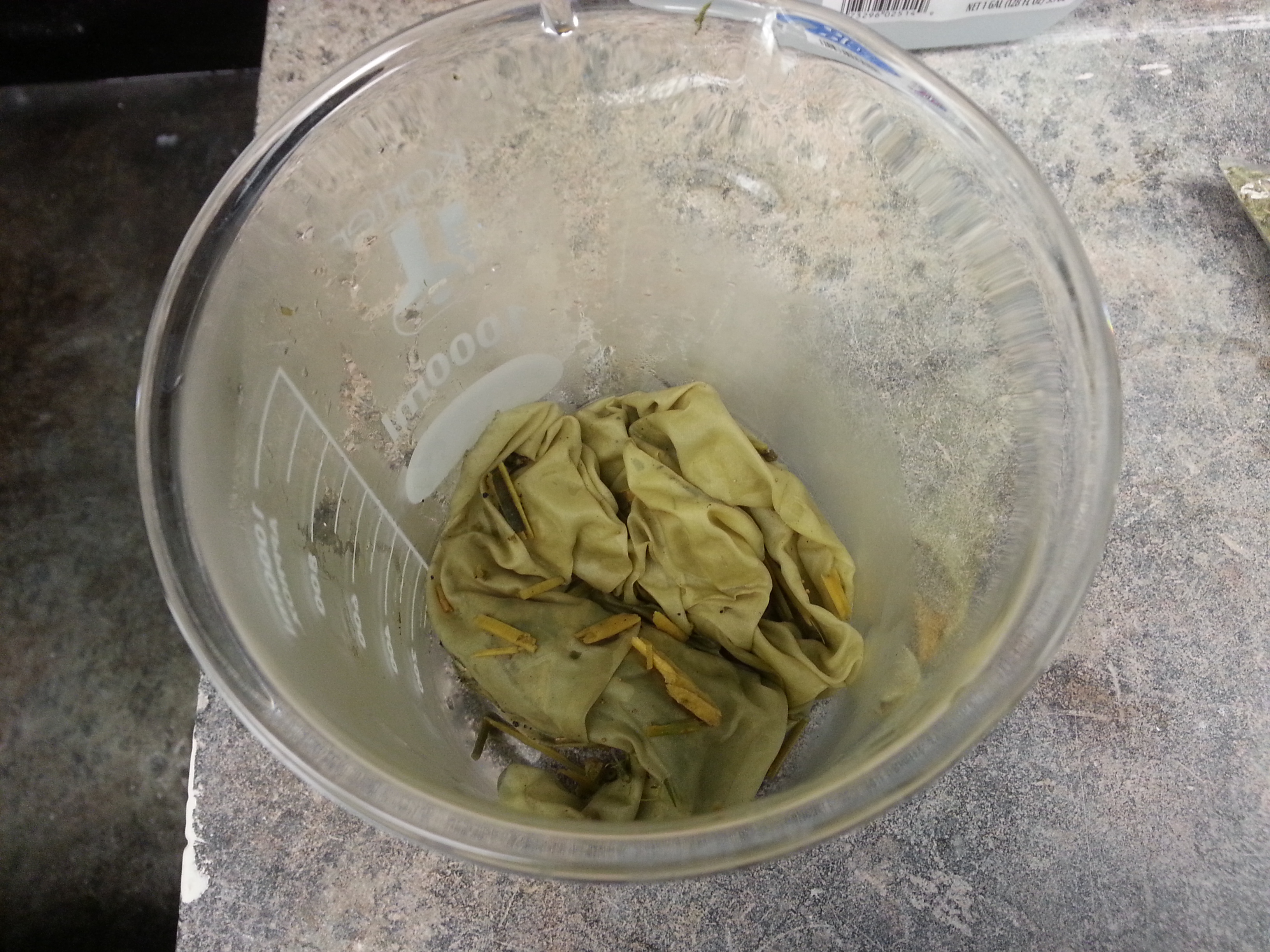
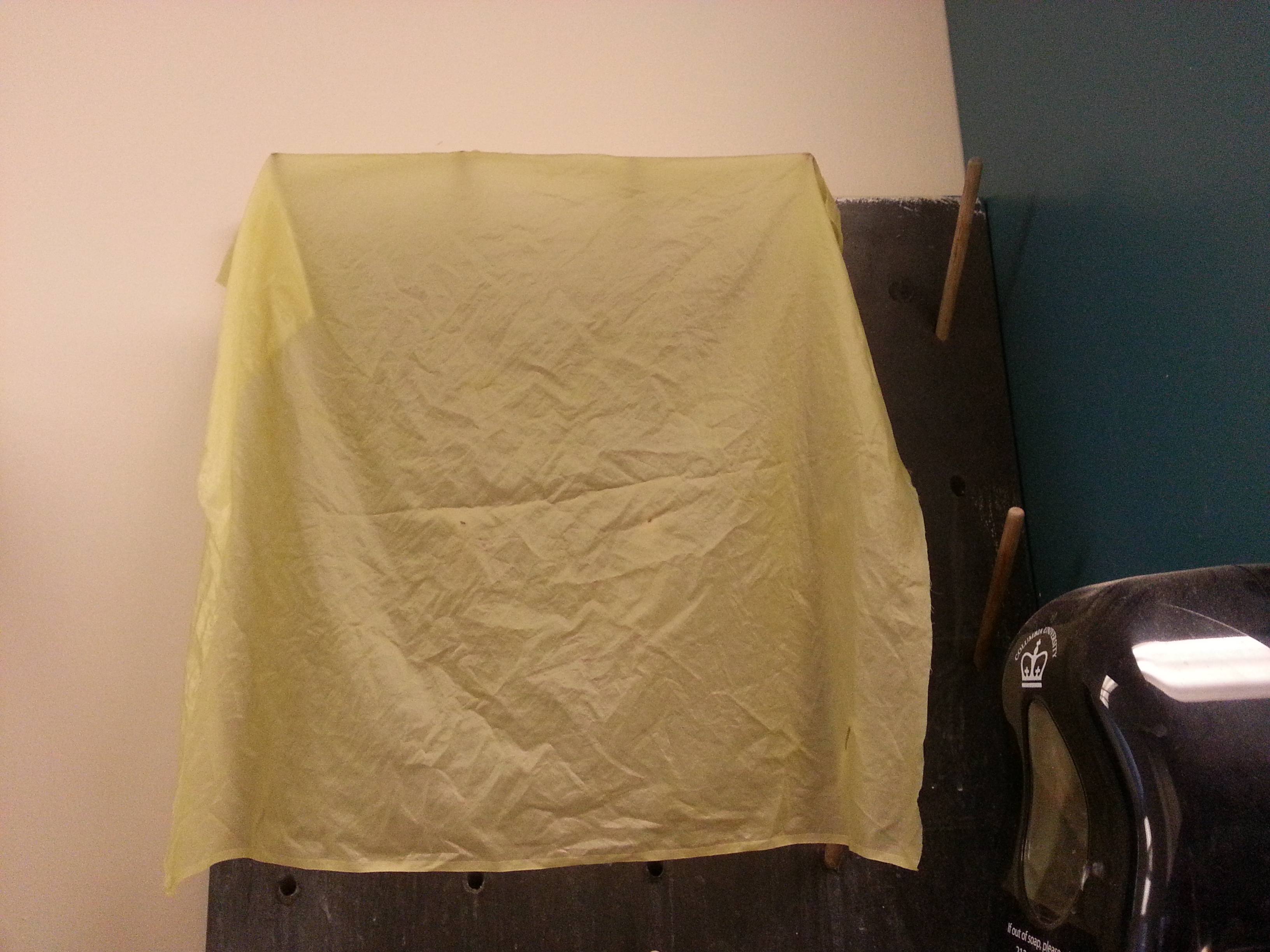
- fabrics before and after dyeing (from left cotton, silk, and linen)
[Patterning]
Name: Yuan, Jenny
Date and Time:
2015. Nov. 24, 2:15-5:00 PM
Location: Chandler 260Subject: Translation of the primary recipe
Conducting experiments to reconstruct the primary recipe has forced me to engage with the text more actively and carefully, While re-reading the original recipe for experiments, I have come to raise a new question: is the author-practitioner suggesting to make two separate imitations--one for damask the other for embroidery--or just one piece of imitation that combined the two? I re-read the original French recipe and its English translation with Jenny.
French Text
<title id=“p015r_a1”>Drap damasse</title>
<ab id=“p015r_b1”>Tu peulx damasser un drap de deux differentes couleurs<lb/>
et imiter la broderie sans adjouster aulcune chose a iceluy en ceste<lb/>
sorte Co{mm}e il est tainct en jaulne ponce dessus tel patron quil te<lb/>
plaira puys tu faulfileras de la fisselle ou plus grosse cordette<lb/>
sur le poncis et le boutte en la teincture de guesde ou pastel & il<lb/>
se fera vert hormis ce qui est dessoubs la fisselle qui demourera<lb/>
jaulne a cause que la taincture verte ny aura poinct penetre Ainsy<lb/>
pourras tu fayre des aultres couleurs Et au lieu de corde ou fisselle<lb/>
adjoustes sur la premiere couleursdes pieces de meschant drap tailles<lb/>
en forme de moresque En ceste sorte tu auras de la broderie abon<lb/>
marche</ab>
English translation and our re-translation line by line
Damask Cloth
--> Cloth that looks like damask
1) You can make damask cloth of two different colours and imitate embroidery without adding anything else to it, as follows.
--> Our translation 1: You can make cloth of two different colours that looks like damask and (BY DOING SO) imitate the pattern (or the design) (of the damask that you imitate) without adding else to it, as follows.
--> Our translation 2: You can make cloth of two different colours that looks like damask AND imitate embroidery without adding anything else to it, as follows.
Given the following passages that instruct two different ways of making patterns, we've reached a conclusion that our second translation is likely to be the case. It also seems that the author-practitioner had a clear understanding of what damask and embroidery meant, their economic values, and how they were made.
2) Once it is is dyed yellow, pounce onto it such a pattern as will please you.
--> This sentence seems okay.
3) Then you will sew some string or a bigger cord loosely onto the pattern and throw it into a dye of woad or pastel and it will become green, except that which is beneath the string, which will remain yellow because the green dye will not have penetrated there.
--> Our translation: Then you will sew some string or a bigger cord PROVISIONALLY (not loosely) onto the pattern and throw it into a dye of woad or pastel and it will become green, except that which is beneath the string, which will remain yellow because the green dye will not have penetrated there.
When I first read this sentence I thought it did not make sense at all. First one cannot sew cloth WITH strings or cords because they are likely to leave huge holes on the cloth once removed (also I doubted if there was such a needle suitable for big strings or cords) Second, by sewing them loosely, one can hardly expect the effect of resist-dye. As for the first issue, Jenny said the author-practitioner possibly meant sewing them onto the cloth with finer threads, which seems to makes sense. But can we achieve resist-dye effects by sewing them loosely? Given dye’s tendency to run through the fibers of cloth,it seemed unlikely that the desired dye-resist effect would be obtained by sewing strings “loosely”to block the targeted area. To achieve dye-resis effects, one has to block the area very tightly. We re-examined the verb "faulfiler." The Dictionnaire du Moyen Français (1330-1500) does not have an entry for “faulfiler” but shows that there is an example where “faufiler” was used in the form of “faulfilla” in 1496. The CNRTL(Centre National de Ressources Textuelles et Lexicales) defines "faufiler" as "attaching big ornaments provisionally onto a piece of cloth" (accessed December 3, 2015, http://cnrtl.fr/definition/faufiler). This seemingly minor change in translation, from “loosely” to “provisionally,” can have a huge impact on the feasibility of the recipe. If we do not have to sew strings loosely, by sewing them firmly, if provisionally, chances for them to block the absorption of woad dye into the cloth will become higher, although I still suspect if we can get clear patterns in this manner. As the strings will be removed after dyeing, the term “provisionally” also makes sense here.
Name: Yuan Yi
Date and Time:
2015. Nov. 29, 11:30 AM
Location: Greenbelt, MDSubject: Patterning
- Prepared two pieces of yellow-dyed cotton and two pieces of yellow-dyed silk.
- Decided not to experiment on the linen because of its relatively poor quality of yellow color.
- Prepared pieces of unbleached cotton cut in simplified Moorish shapes (see bottom left).
- Prepared string whose diameter was approximately 8 mm (see bottom right).
- Sewed the materials on the fabrics.
- Tried to stitch them as tightly as possible.
- It was quite challenging to sew the string on the silk, because the fabric was flimsy and so it did not stay still while sewing.
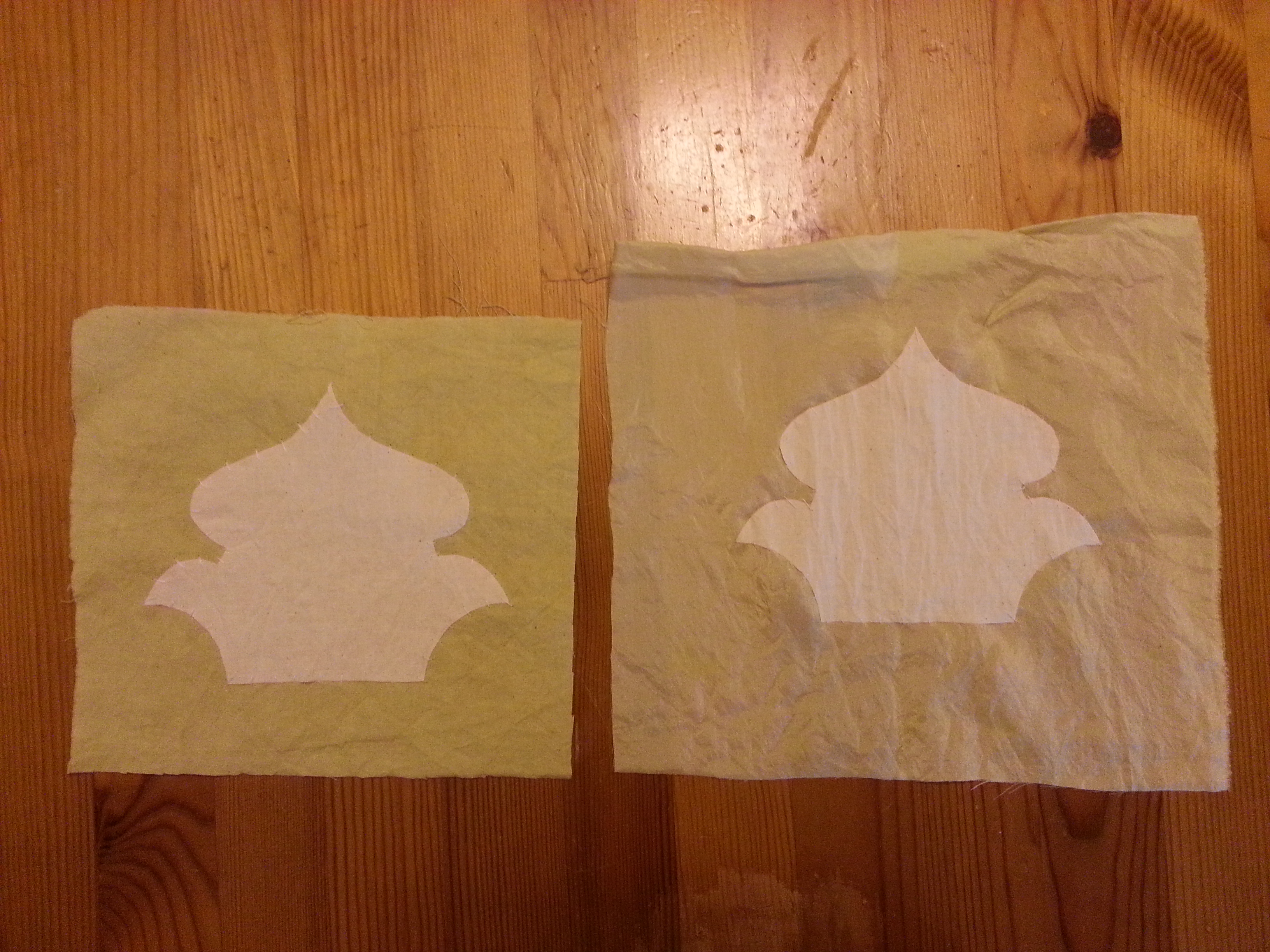
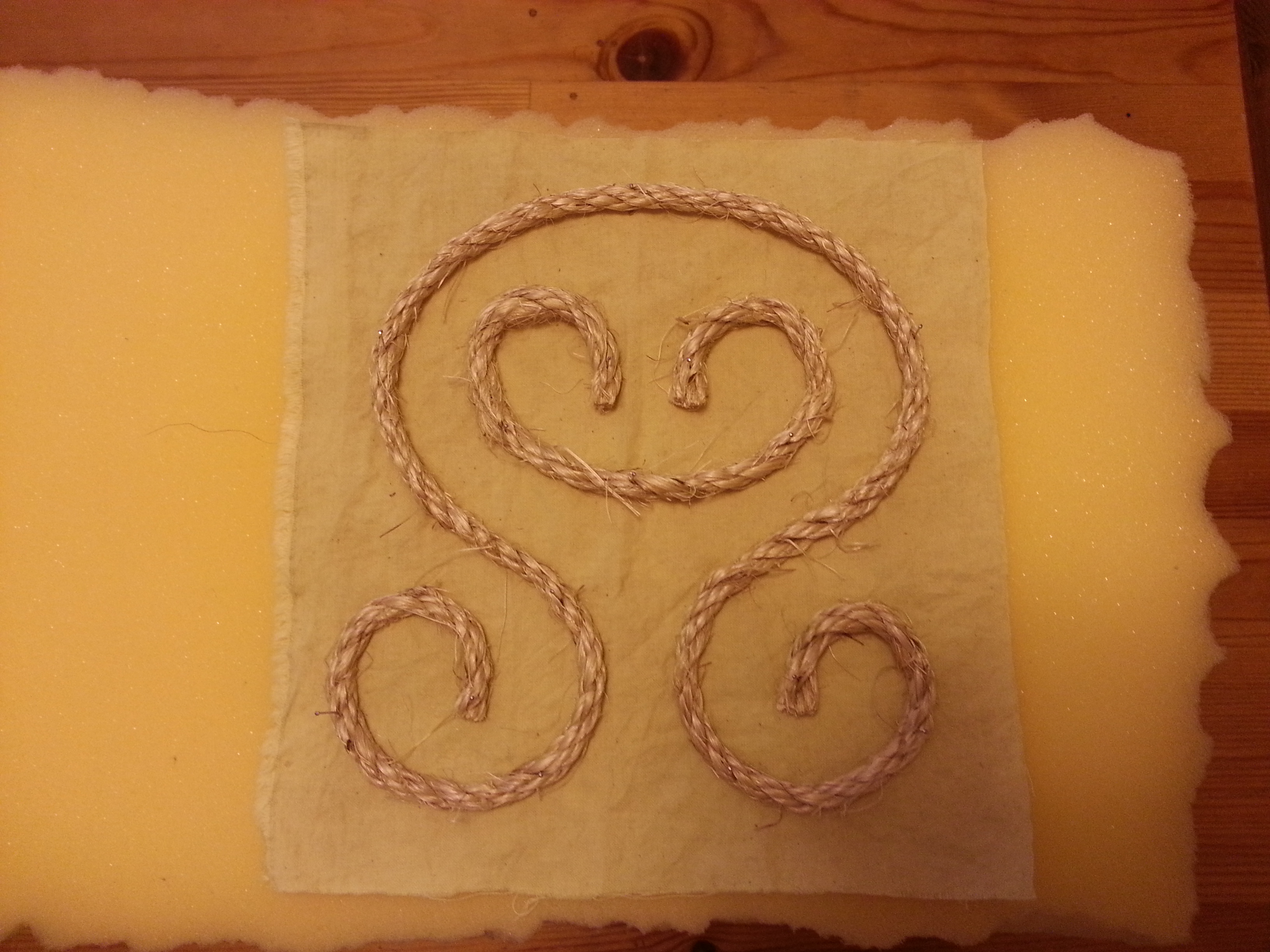
[Dyeing Blue: Woad]
Name: Yuan Yi
Date and Time:
2015. Nov. 29, 7:00 PM
Location: Greenbelt, MDSubject: Dyeing Blue
- Given the time of the experiment, sourcing woad leaves and fermenting them were not possible. We opted for chemical dyeing with woad extracts.
- For our decision-making process for dyeing methods (fermentation or chemical) and materials (fresh woad leaves, woad balls, or woad extracts), see our discussion of preparation of materials.
- We primarily relied on these modern manuals (http://www.woad.org.uk/html/chemical.html http://www.maiwa.com/pdf/natural_dyeing.pdf) and Jo Kirby et al, Natural Colorants.
- Prepared 60 ml of hot water (above 80 °C).
- Measured out 1.6 g of soda ash and added it to the water.
- Placed 2 g of woad extracts in a jar.
- Prepared 6 ml of warm water (approx 50 °C) and poured in the jar. made a smooth paste.
- Added the paste to the soda ash solution and left for 30 min.
- Prepared 0.8 l of warm water (between 40-45 °C).
- Lowered the woad + soda ash solution into the water and let it flow into the water.
- Sprinkled 2 g of thiourea dioxide.
- Poured the solution in a jar and placed it in a large saucepan filled with hot water to keep the temperature constant at 40-45 °C.
- After an hour the solution became a yellow-green color and the surface was covered with purple-bronze bubbles. It was ready for use.
- I soaked each piece of fabric for 10 minutes.
- Note the change of color below. Once the fabric was taken out of the dye, its color changed in seconds.
- I let them oxidize for about 15 min and then rinsed lightly.
- Air-dried overnight.
- Achieved contrasting results on silk and cotton.
<slik>
- left: woad-dyed yellow silk with string attached / right: after removed
- left: woad-dyed yellow silk with a cloth piece attached / after removed
- left: woad-dyed white silk (for comparison) / right: woad-dyed yellow silk with the conventional tie-dye method (for comparison) (patterns are created)
- In summary, no pattern was created on silk in the sets designed as instructed in the recipe. Comparison with the result from the conventional tie-dye method make it clear.

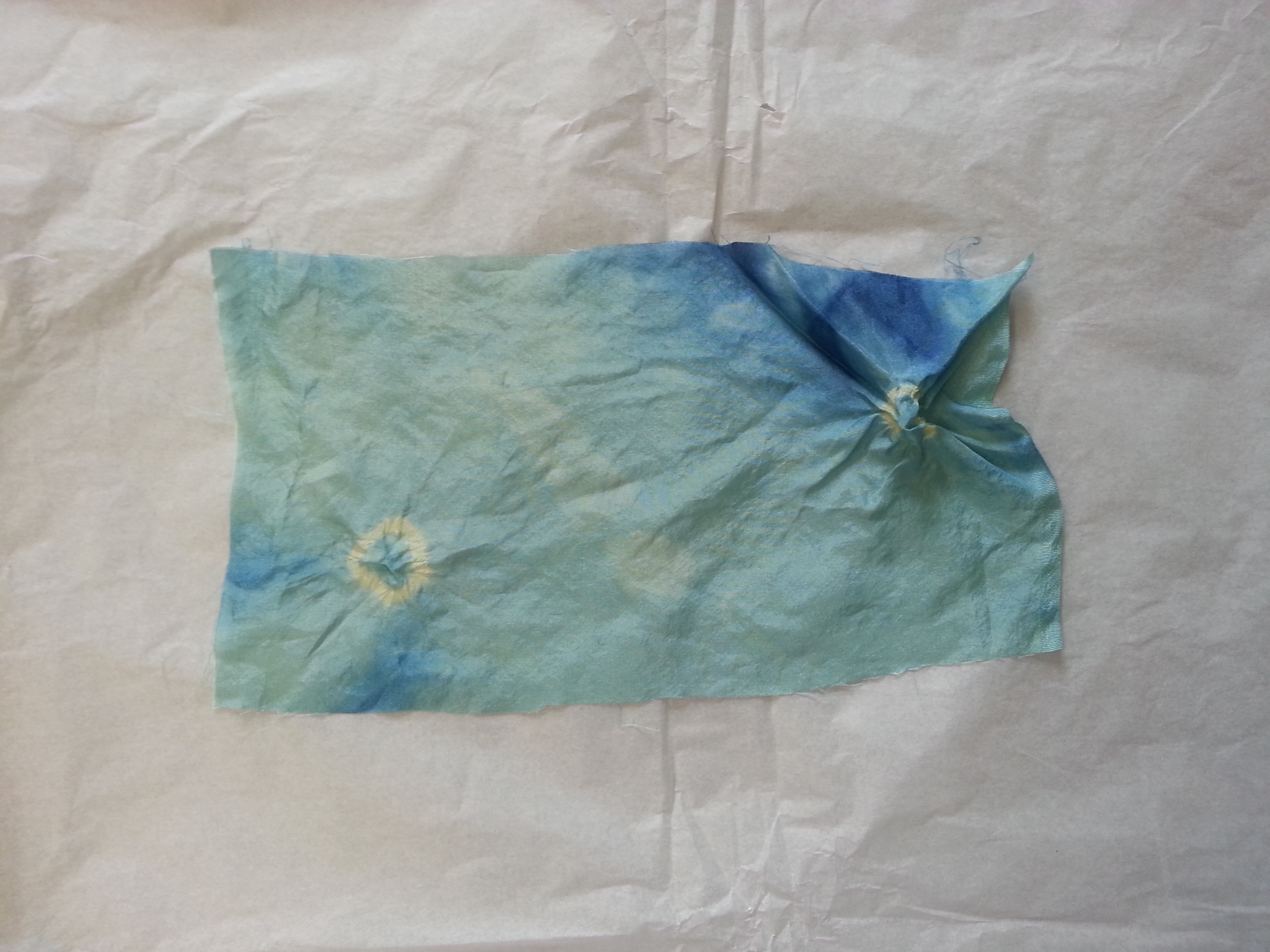
<cotton>
- left: woad-dyed yellow cotton with string attached / right: after removed (a faint pattern is created)
- left: woad-dyed yellow cotton with a cloth piece attached / after removed (a faint pattern is created)
- left: woad-dyeing on unbleached, undyed cotton (for comparison)/ right: woad-dyed yellow cotton with the conventional tie-dye method (for comparison) (patterns are much clearer)
- On cotton, we obtained greenish-yellow patterns, if not perfect.


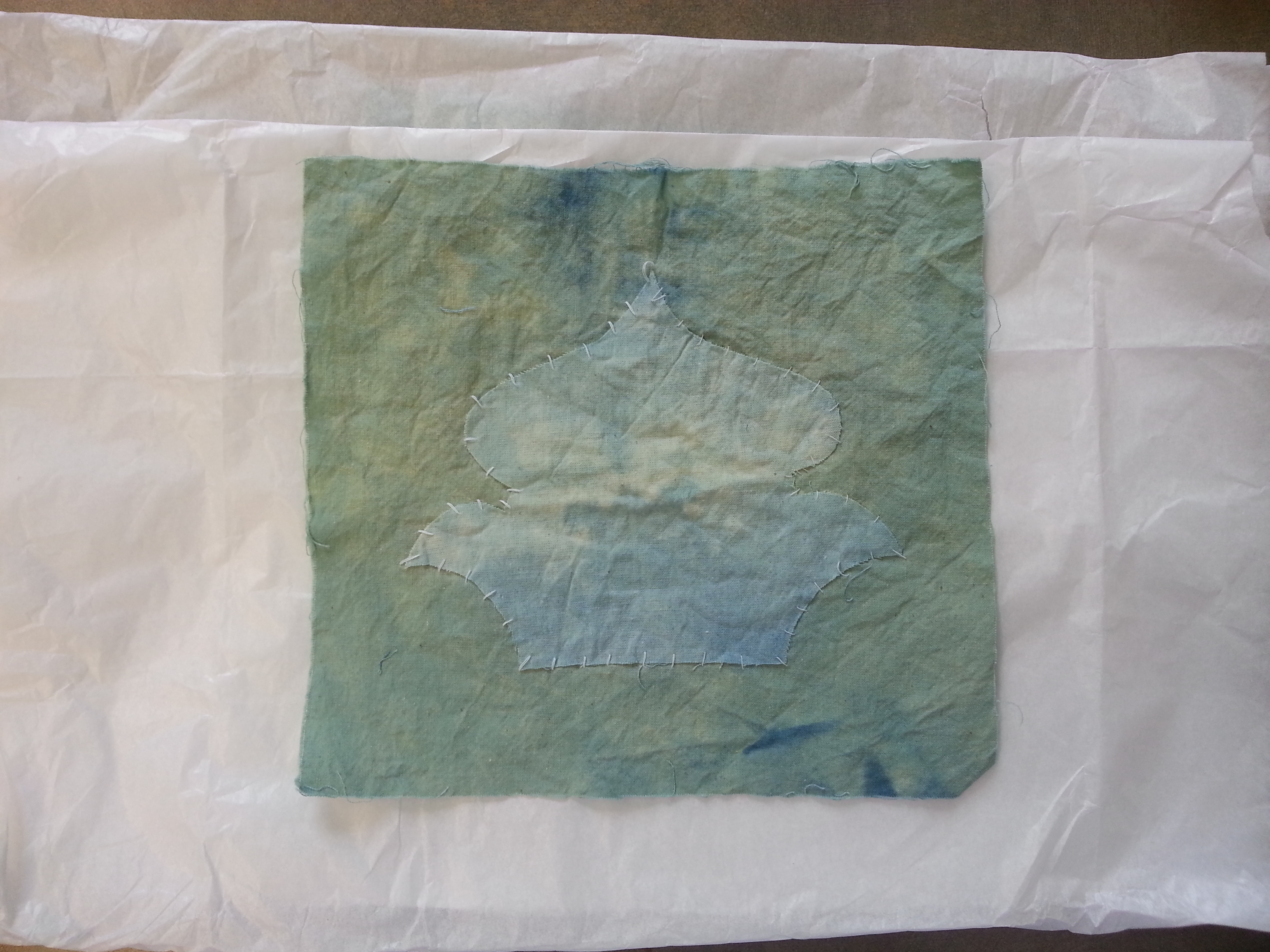


Name: Yuan Yi
Date and Time:
2015. Dec. 13, 2:00 PM
Location: Greenbelt, MDSubject: Dyeing Blue With Woad Ball
There is one recipe in Ms Fr 640 that talks about the process of woad dyeing:
<head><m>Dyers woad</m></head>
<ab>It is grown in <pl>Auragnes</pl> where the soil is so fertile that if you grew wheat there
every year, it would fall over from the kernels being too full. This is why <m>dyers woad</m>
and wheat are cultivated alternately. For cultivating </m>dyers woad</m>, the soil is ploughed
with <m>iron</m> shovels like those of gardeners. Then with rakes, clods of earth are broken
up and tilled as for the sowing of some vegetable gardens. It is usually sowed on Saint
Anthony’s day in January. Eight harvests can be made. The first ones are the best. The best of
Auragne’s <m>dyers woad</m> is the one from <pl>Carmail</pl> and the one from
<pl>Auraigne</pl>. And sometimes the <m>dyers woad</m> is good in one field and worthless
in another that is closeby. The quality of the <m>dyers woad</m> can be recognized when you
put it in your mouth and it tastes like vinegar, or when you crumble and break it, there are silver
or golden moldlike veins. It is pressed in the dyers’ cistern, and to fill a cistern, six bales are
needed. Several <m>wool</m> flocks are kept there. And if it produces 15 dyings, it is said to
be worth 15 florins, if it produces 20 dyings, 20 florins. The good kind will dye up to 30 times and
usually up to 25 or 26.</ab>
- This recipe does not discuss fermentation at all, which made us raise a strong doubt about the efficacy of the procedure.
- We already obtained blue colors through chemical dye but just decided to give it a try to see if the instruction laid out in the recipe works.
- It was already too late to source fresh woad leaves, so we used a dry woad ball imported from the UK.
- We soaked it in water, then added silk and cotton in the solution, as instructed in the recipe.
- Let them soak for 2 hours.
- We obtained faint brown colors on both fabrics. No blue color was created.
- According to the early modern method the woad ball needs to go through fermentation (or chemical process which we opted for), without which no blue color is obtained.
- Even if we had used fresh woad leaves, we presume the result would not have been greatly different.
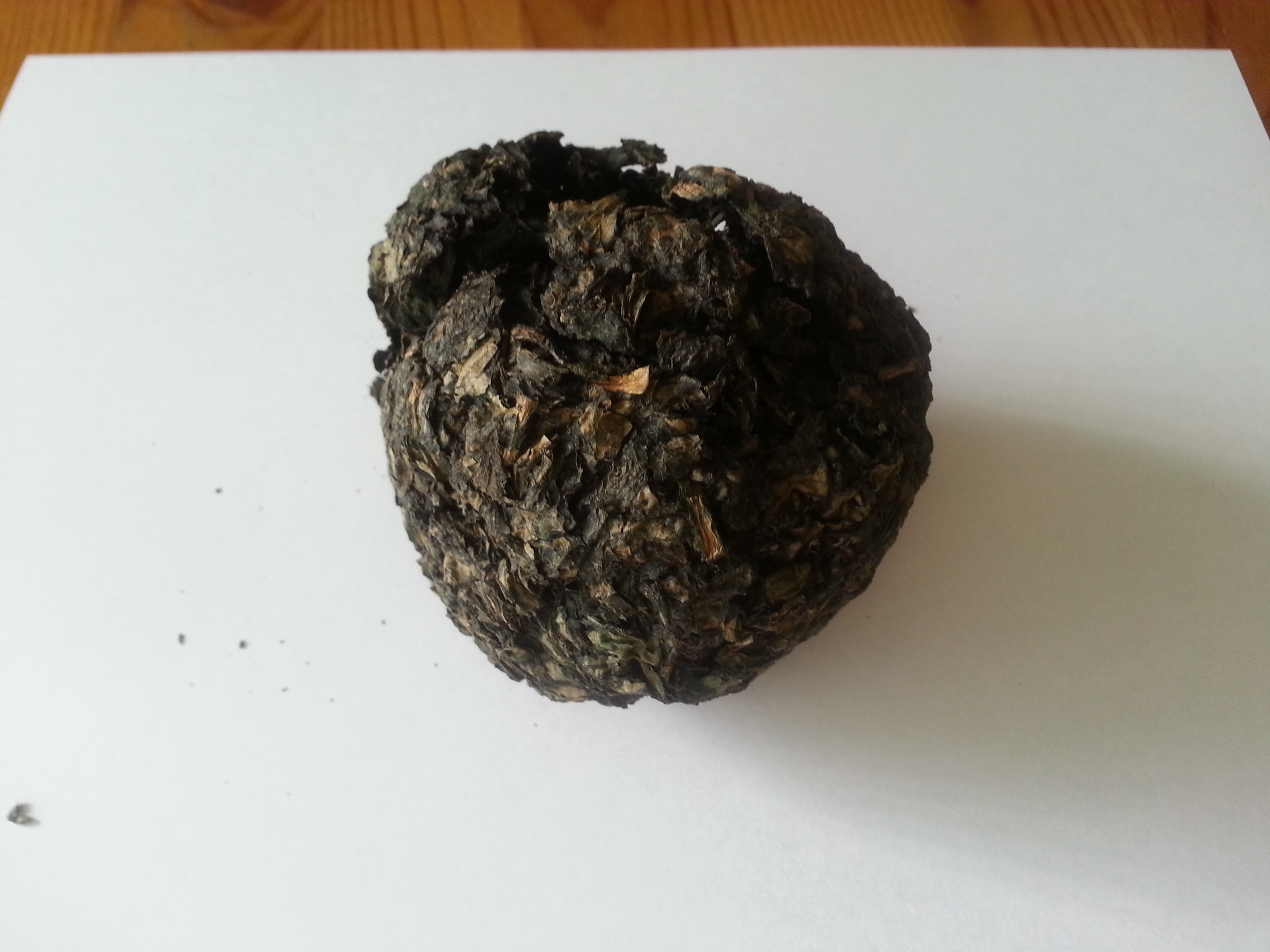

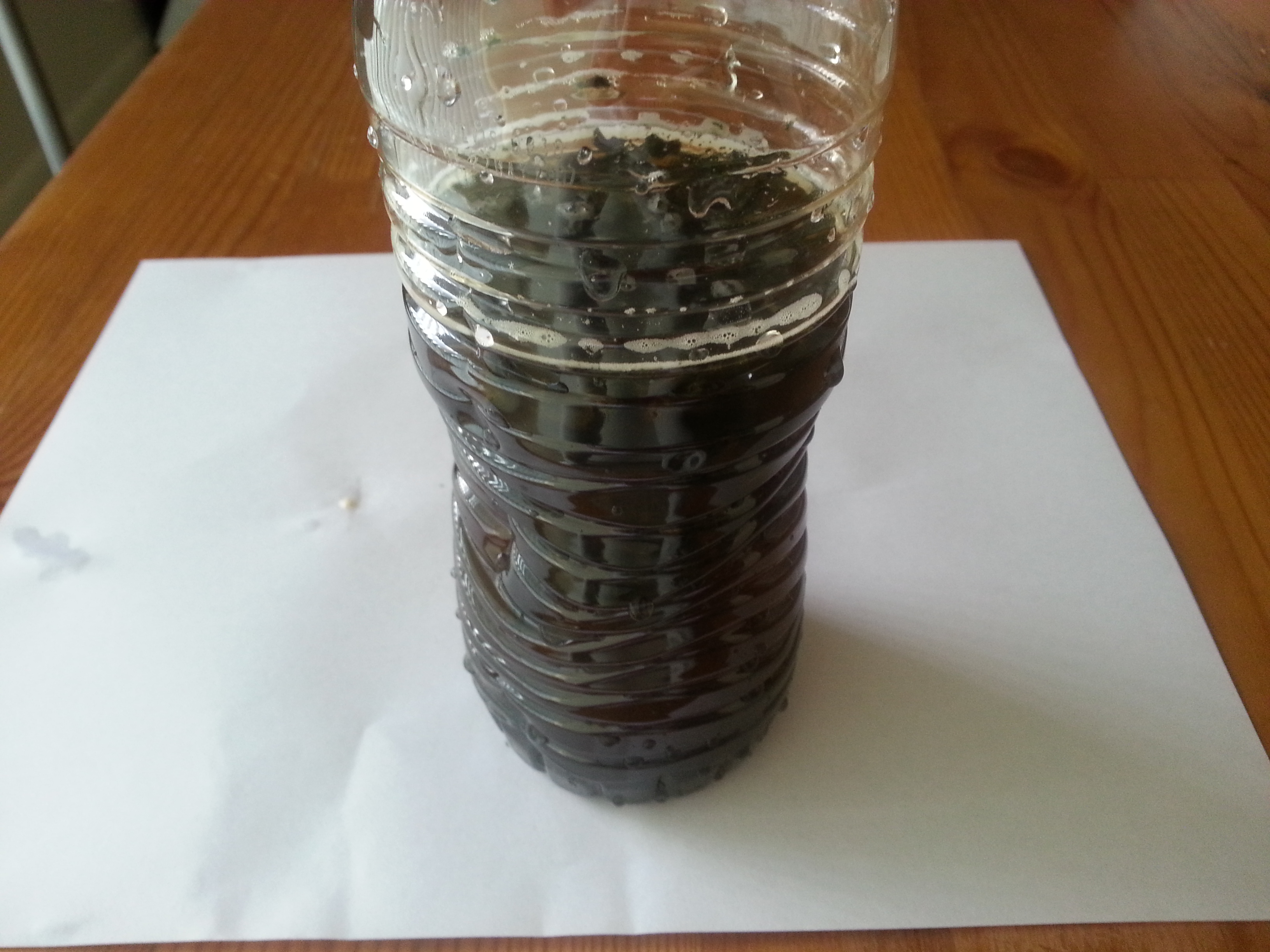
ASPECTS TO KEEP IN MIND WHEN MAKING FIELD NOTES
- note time
- note (changing) conditions in the room
- note temperature of ingredients to be processed (e.g. cold from fridge, room temperature etc.)
- document materials, equipment, and processes in writing and with photographs
- notes on ingredients and equipment (where did you get them? issues of authenticity)
- note precisely the scales and temperatures you used (please indicate how you interpreted imprecise recipe instruction)
- see also our informal template for recipe reconstructions
